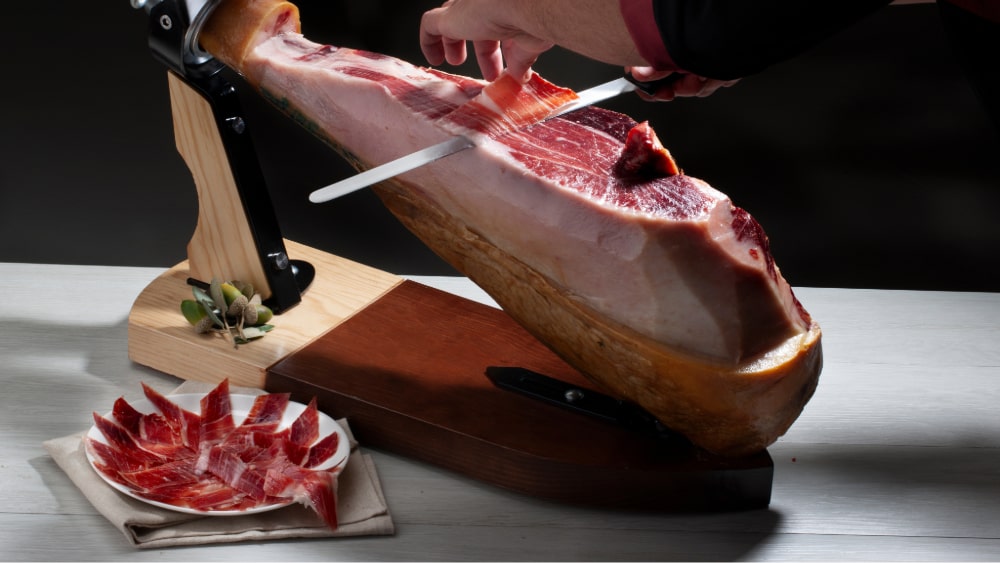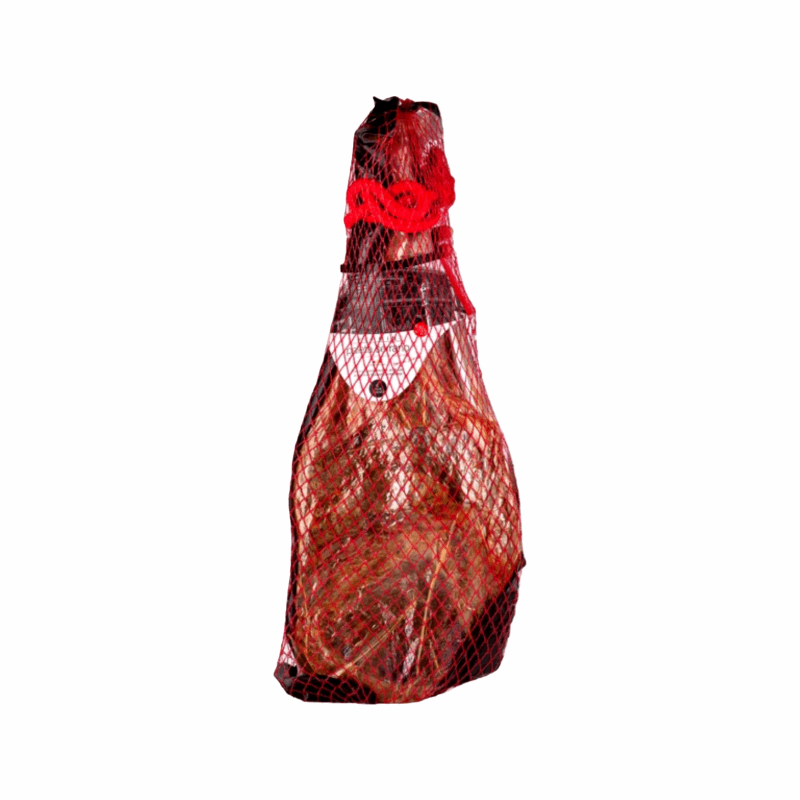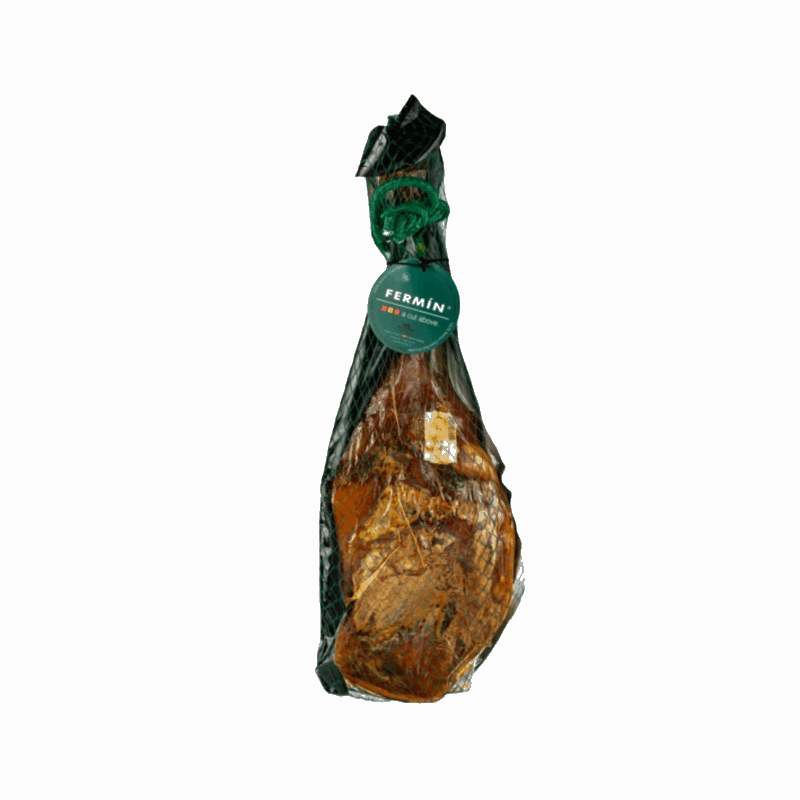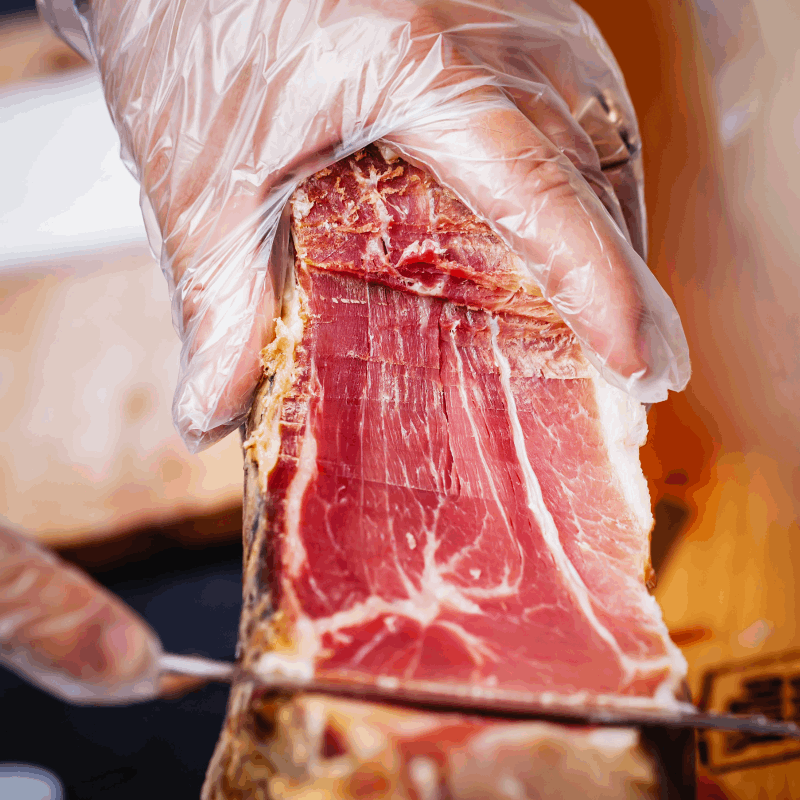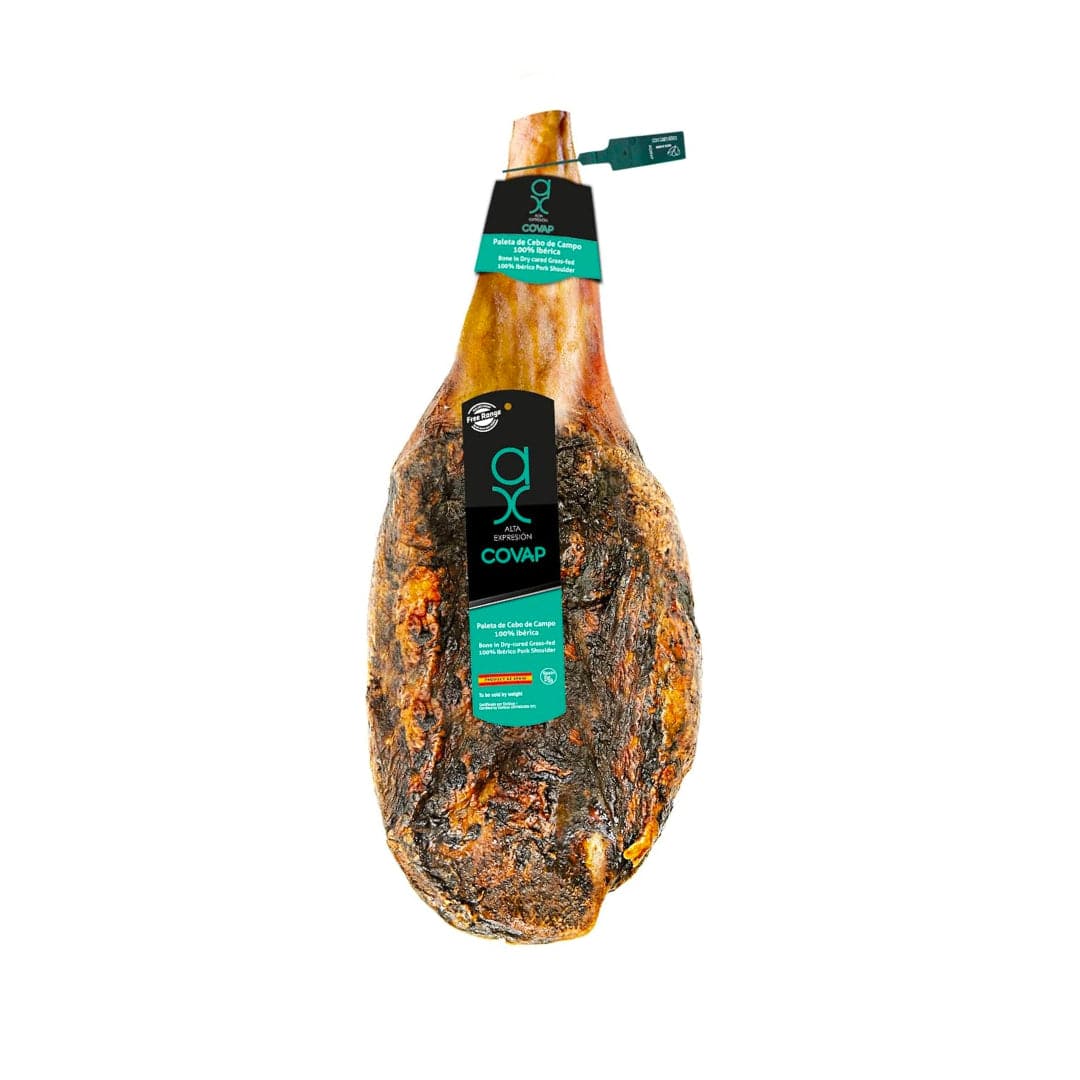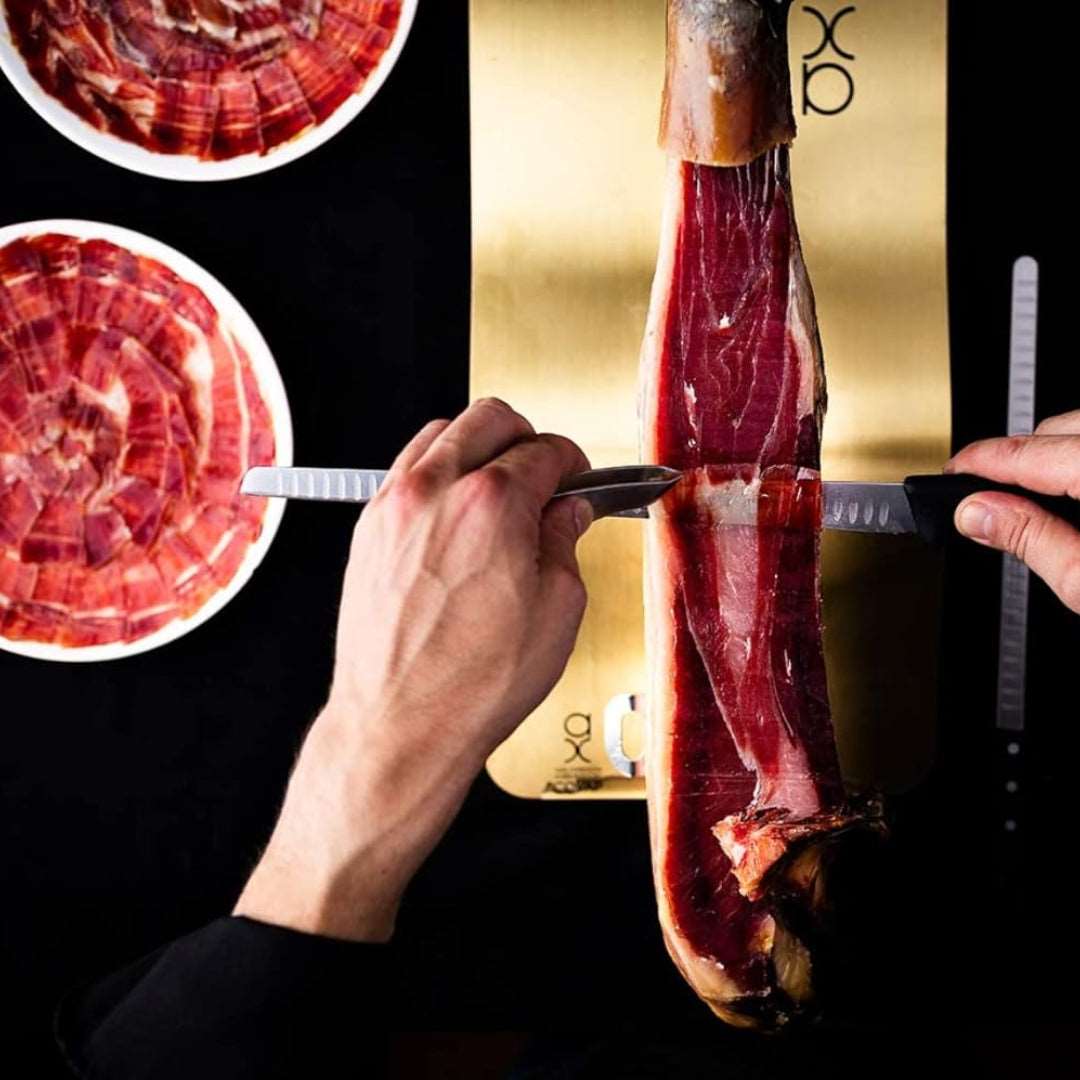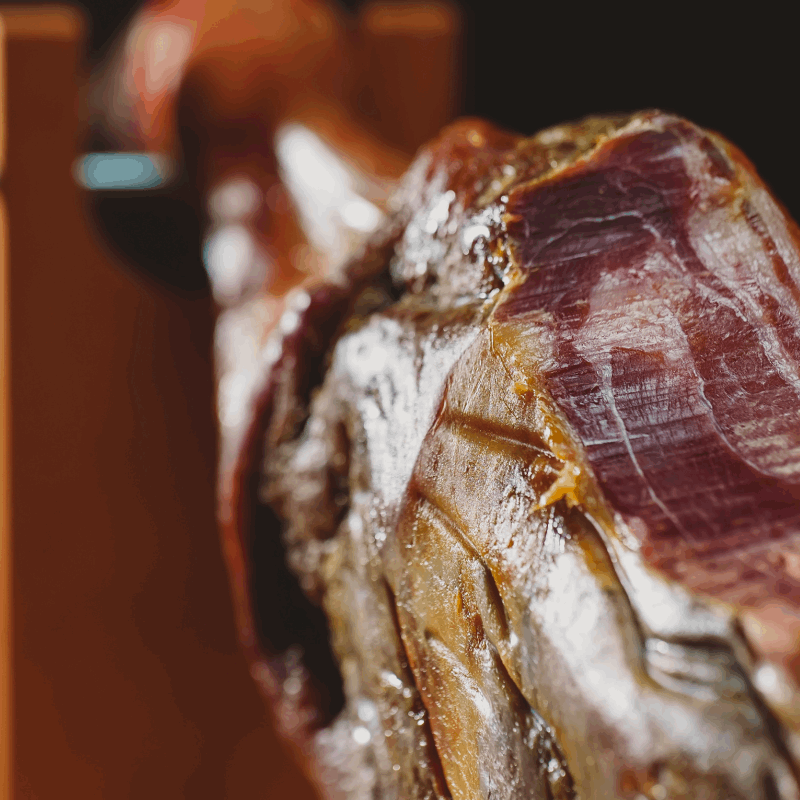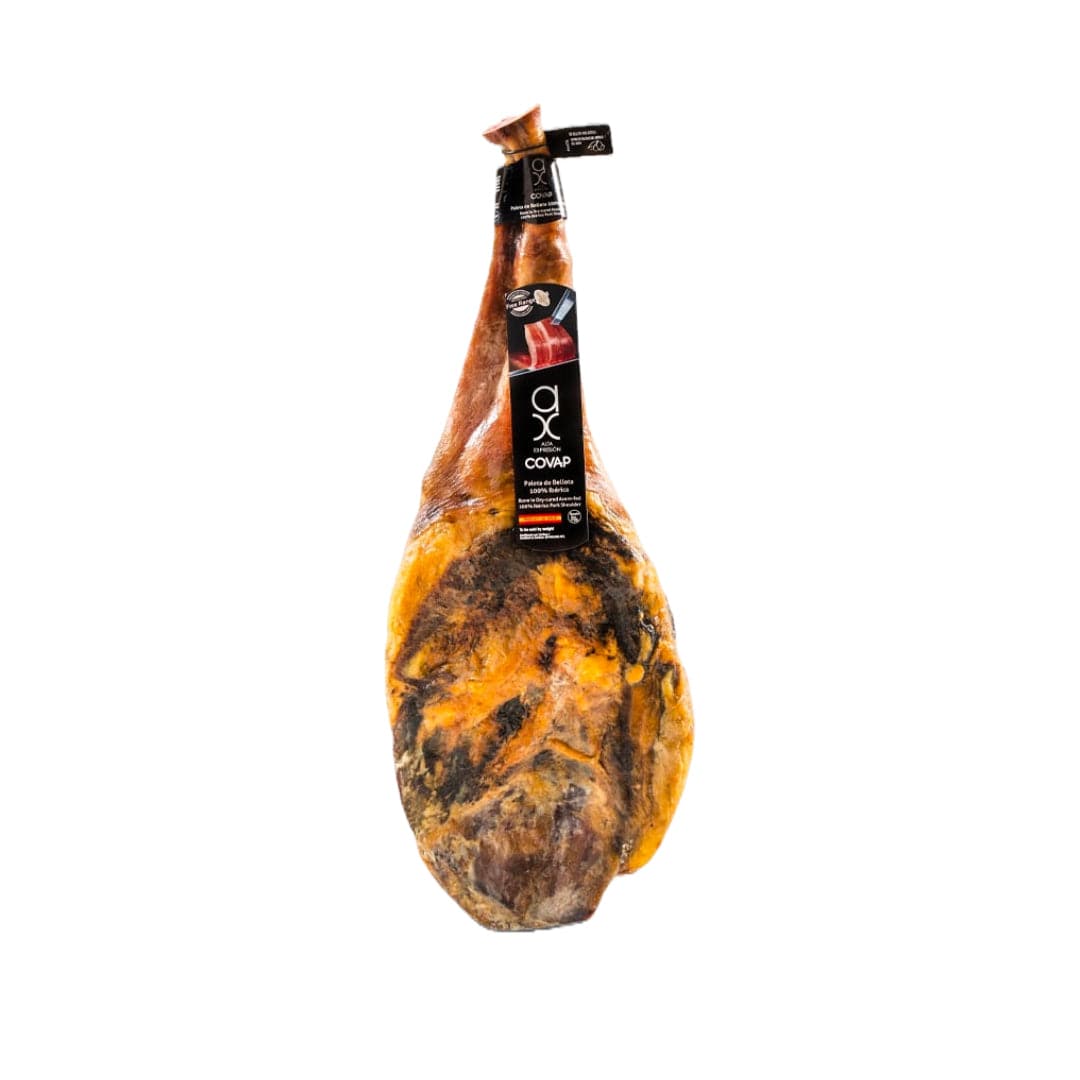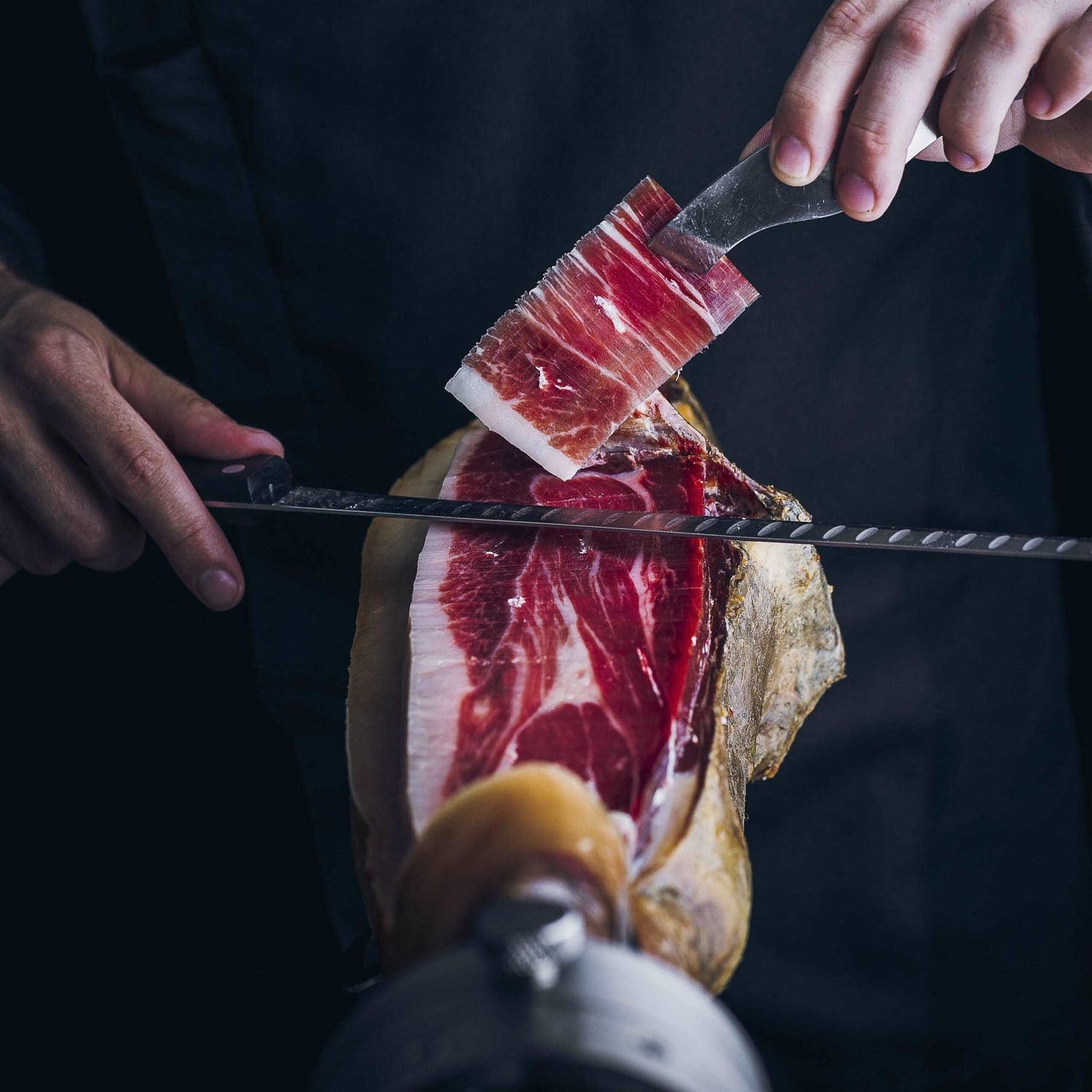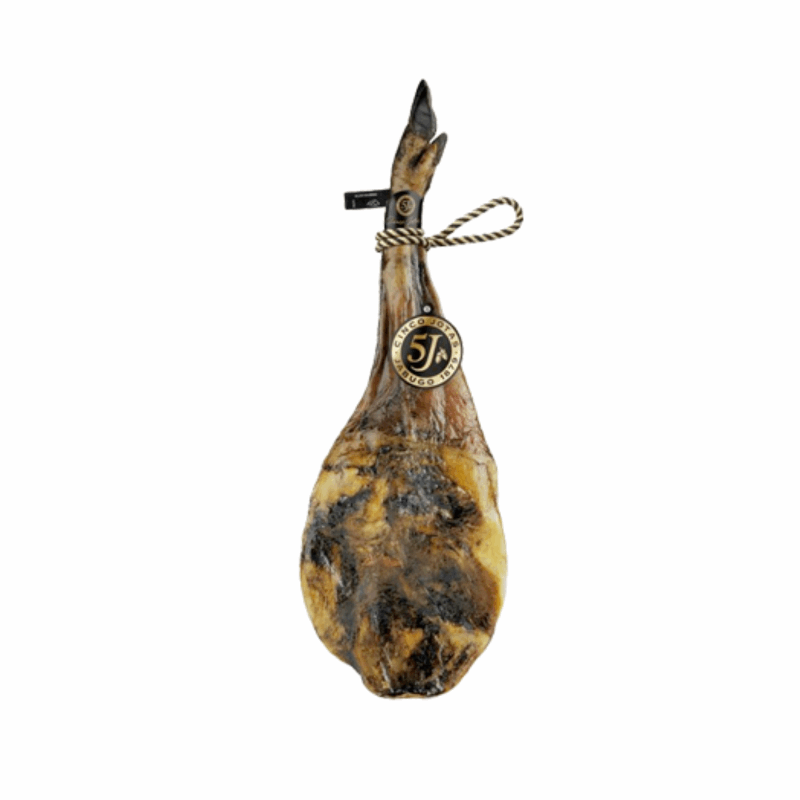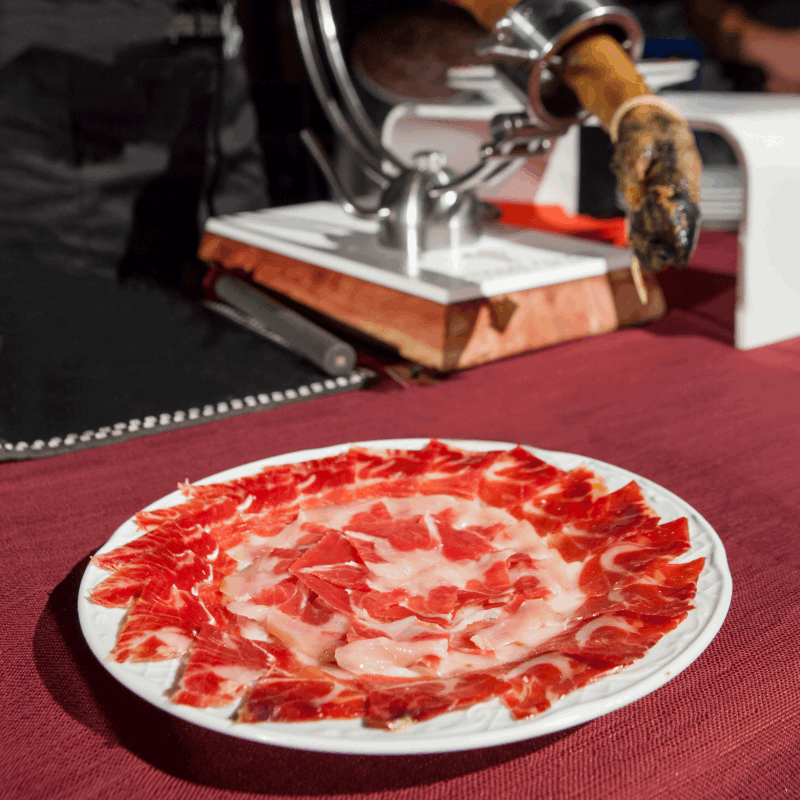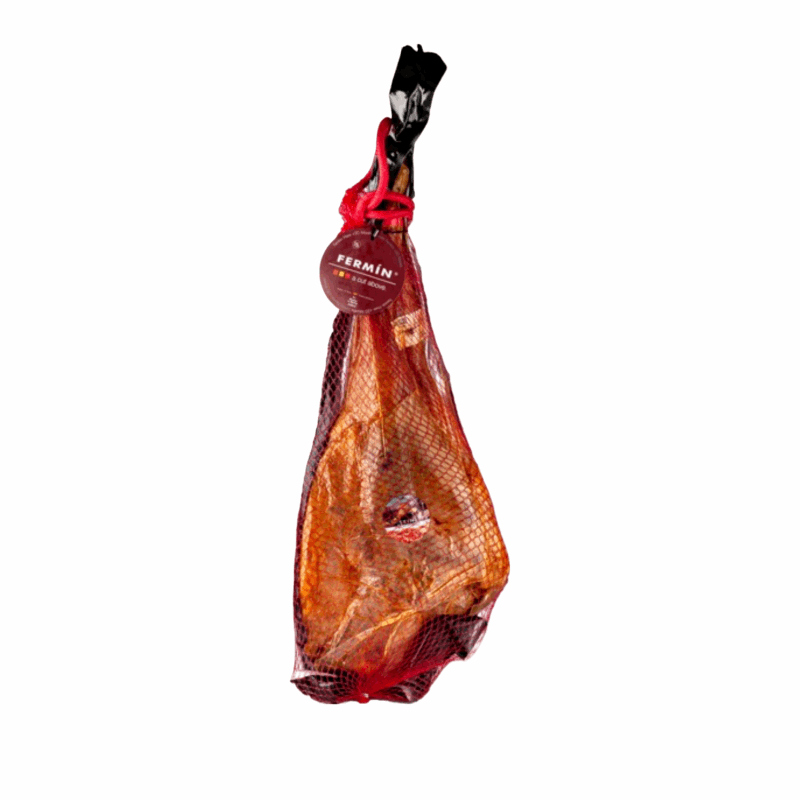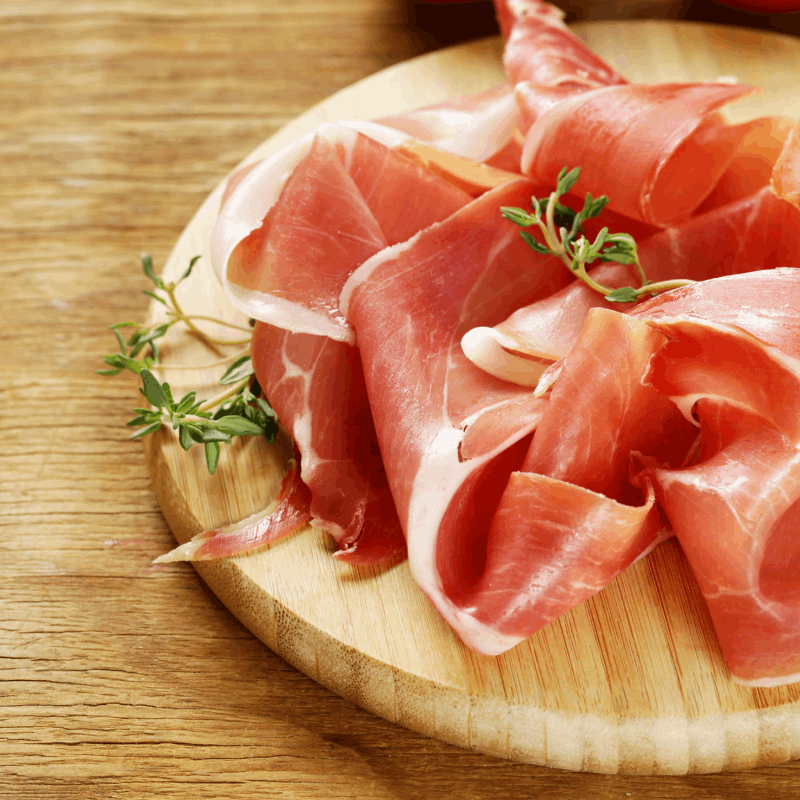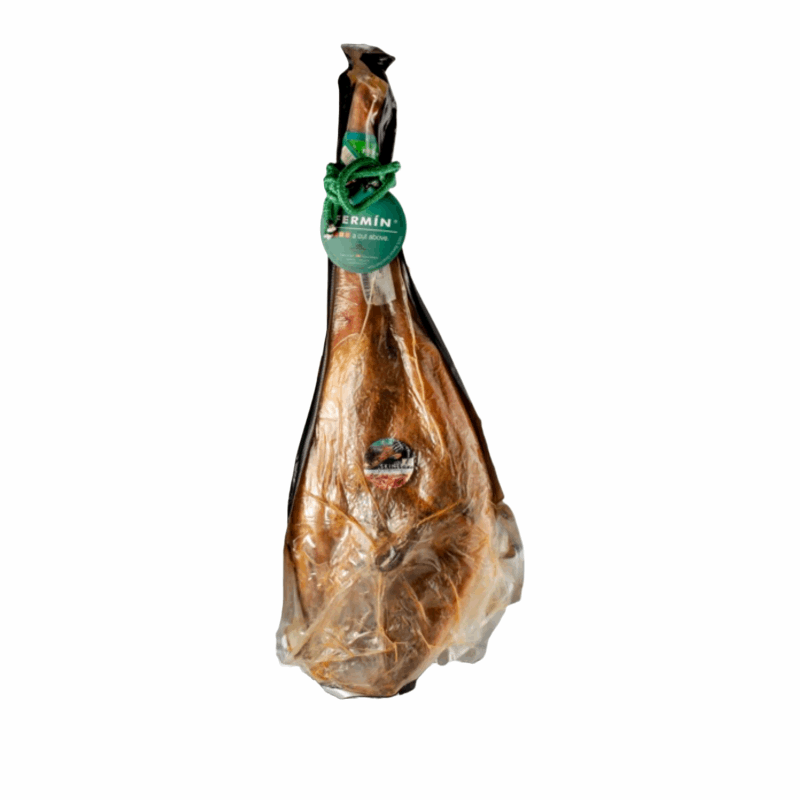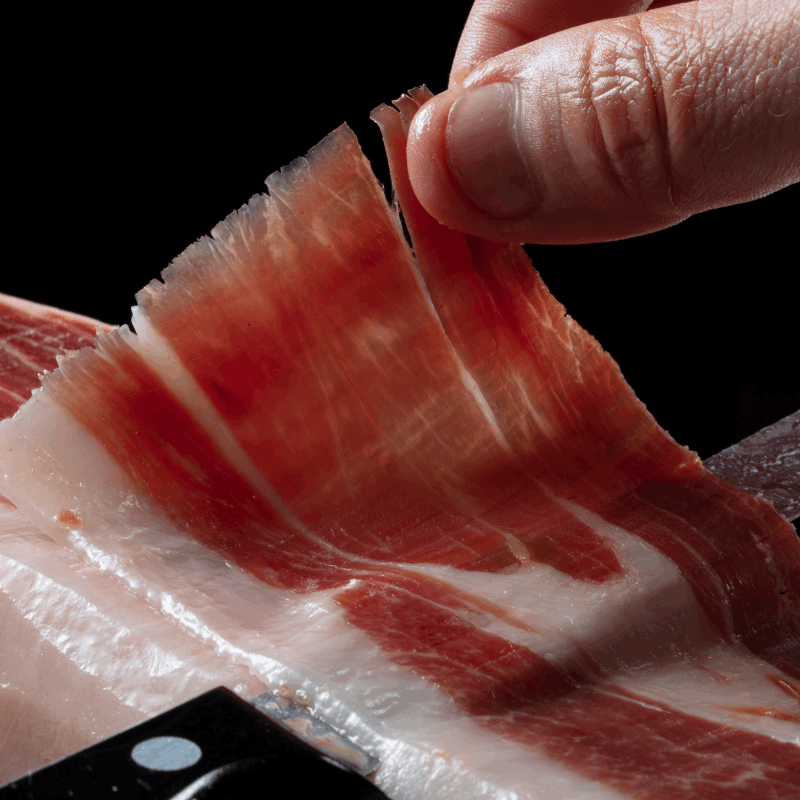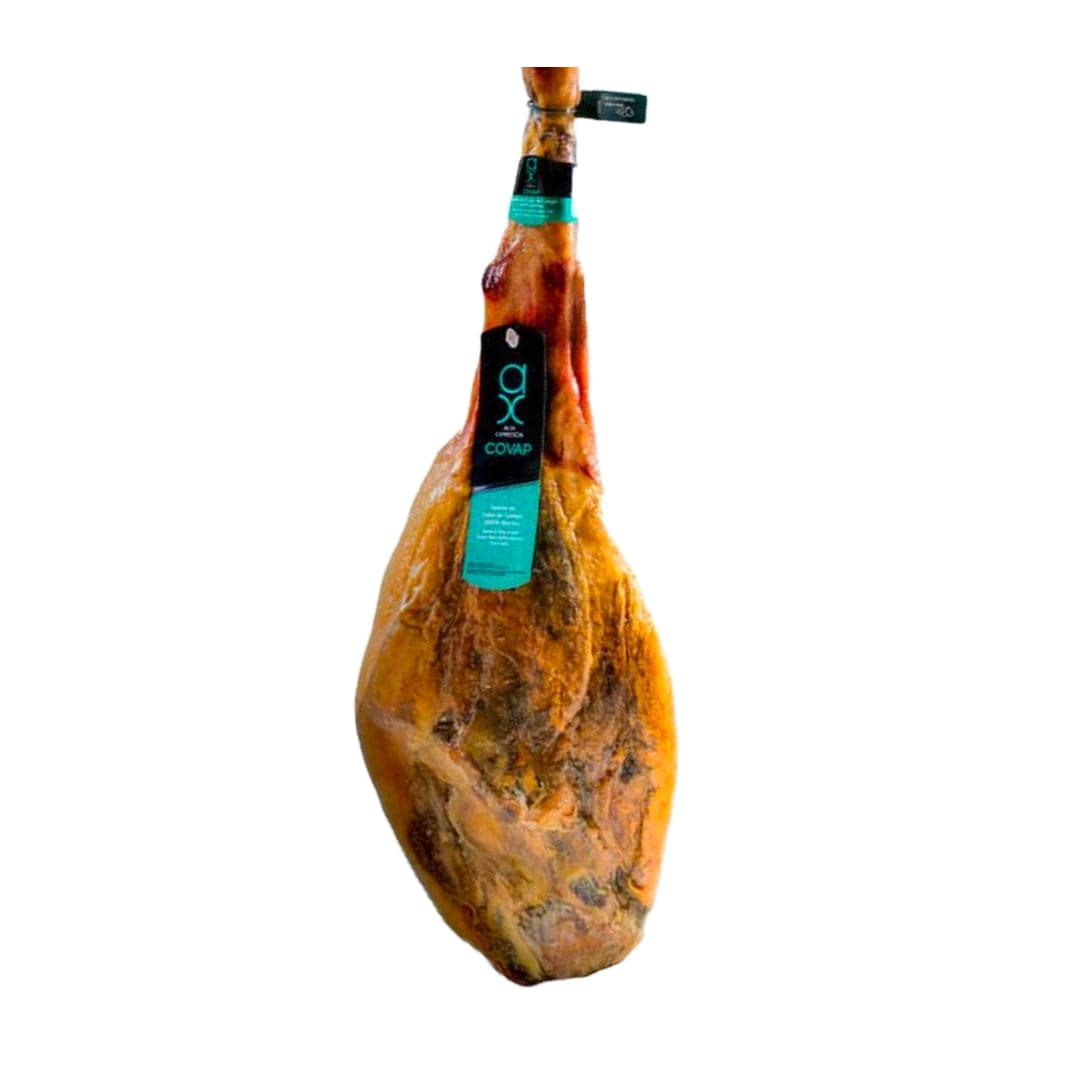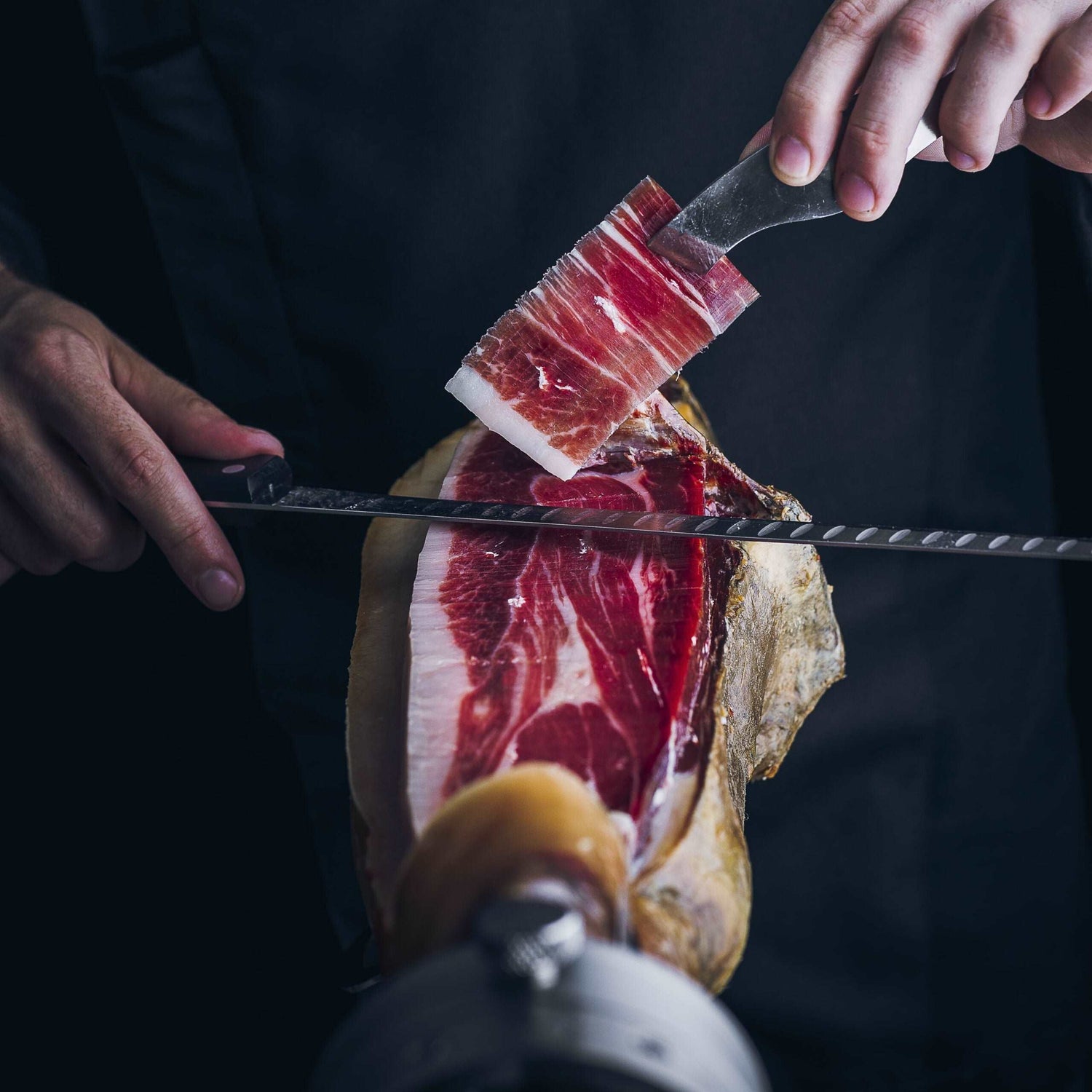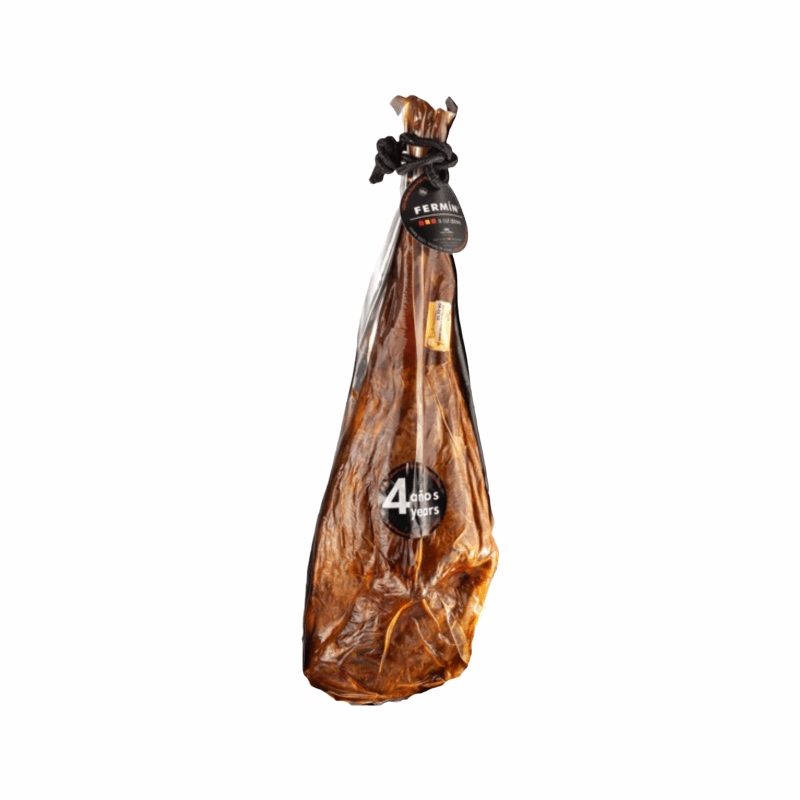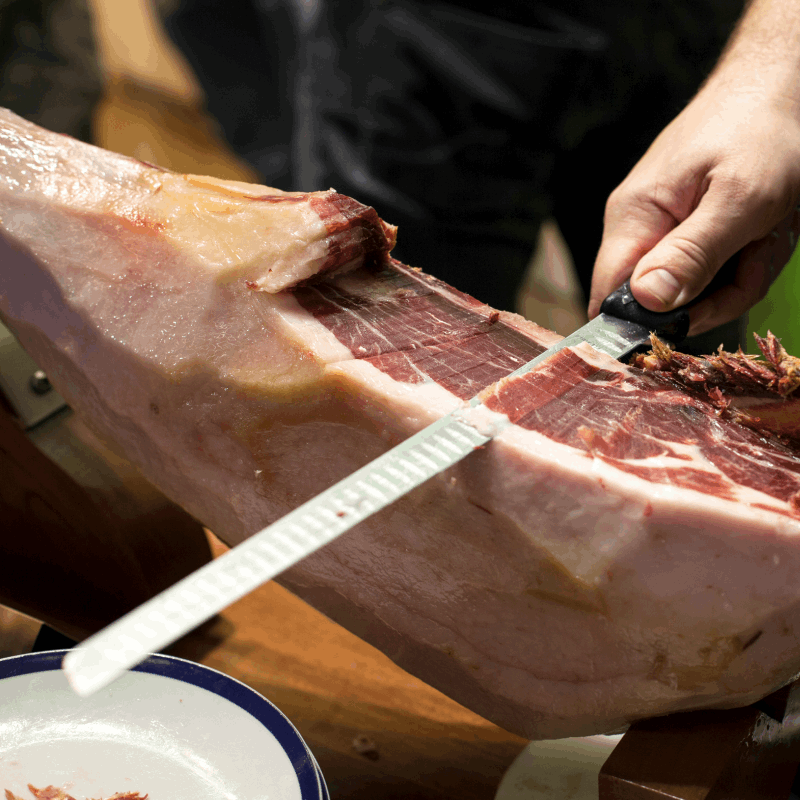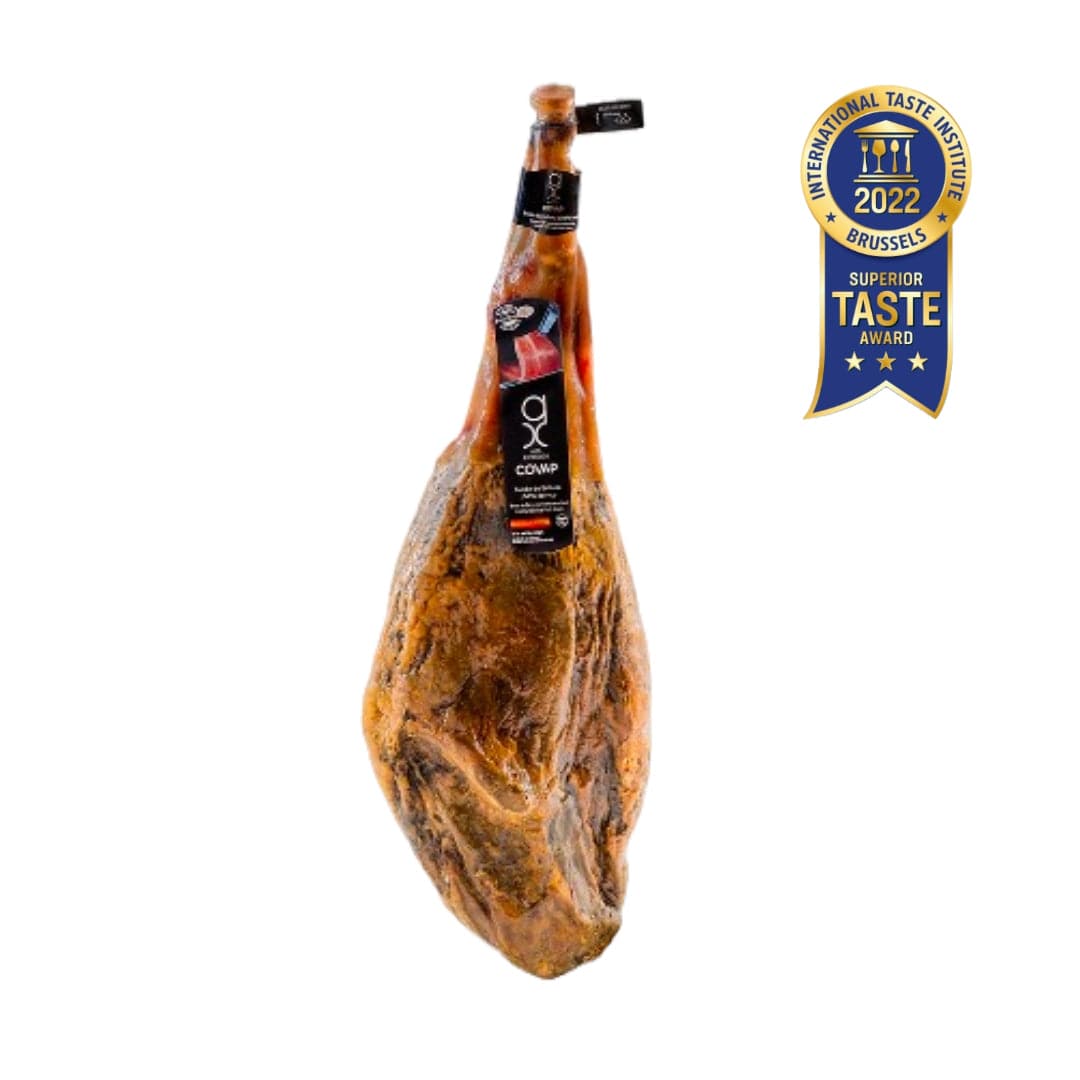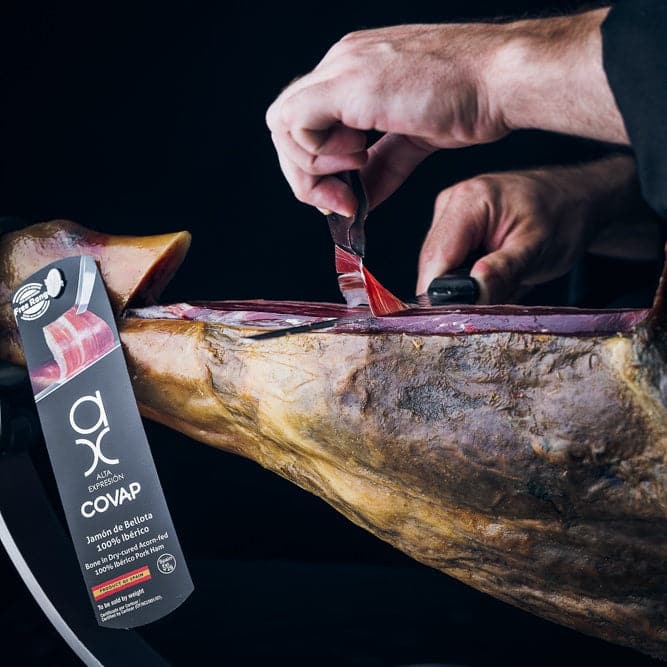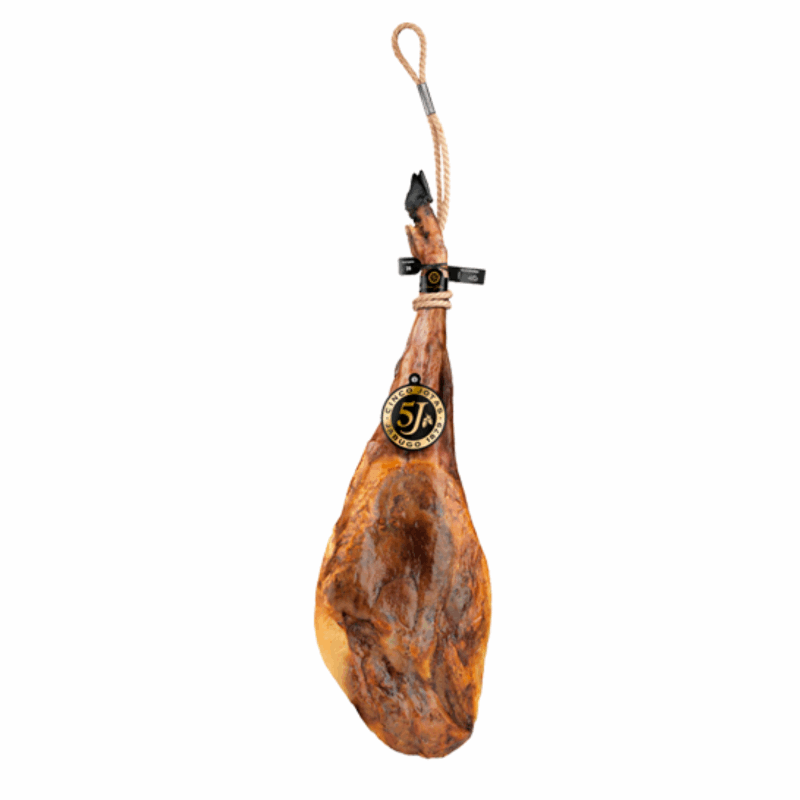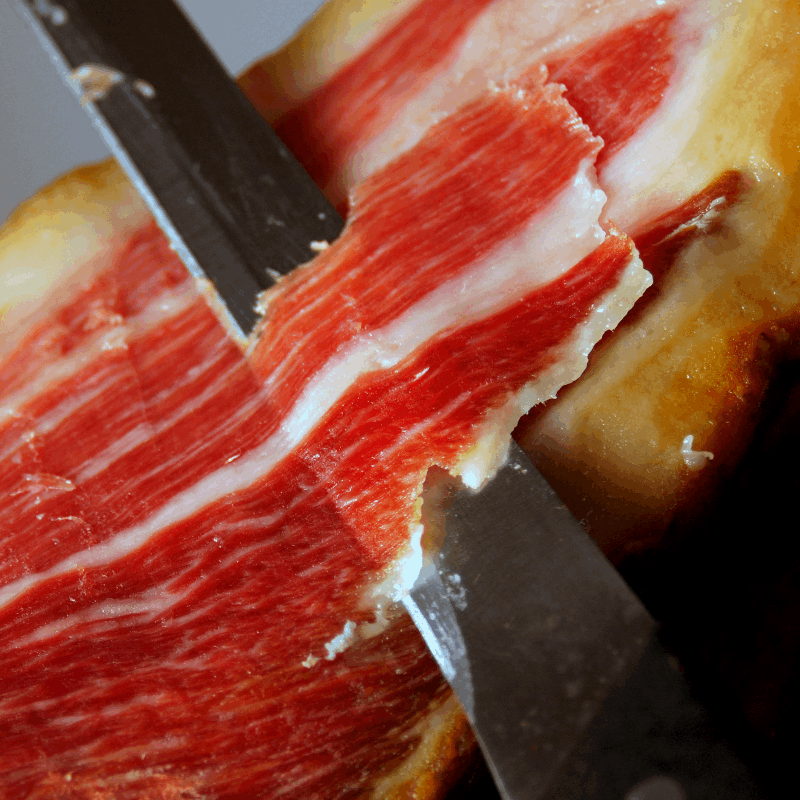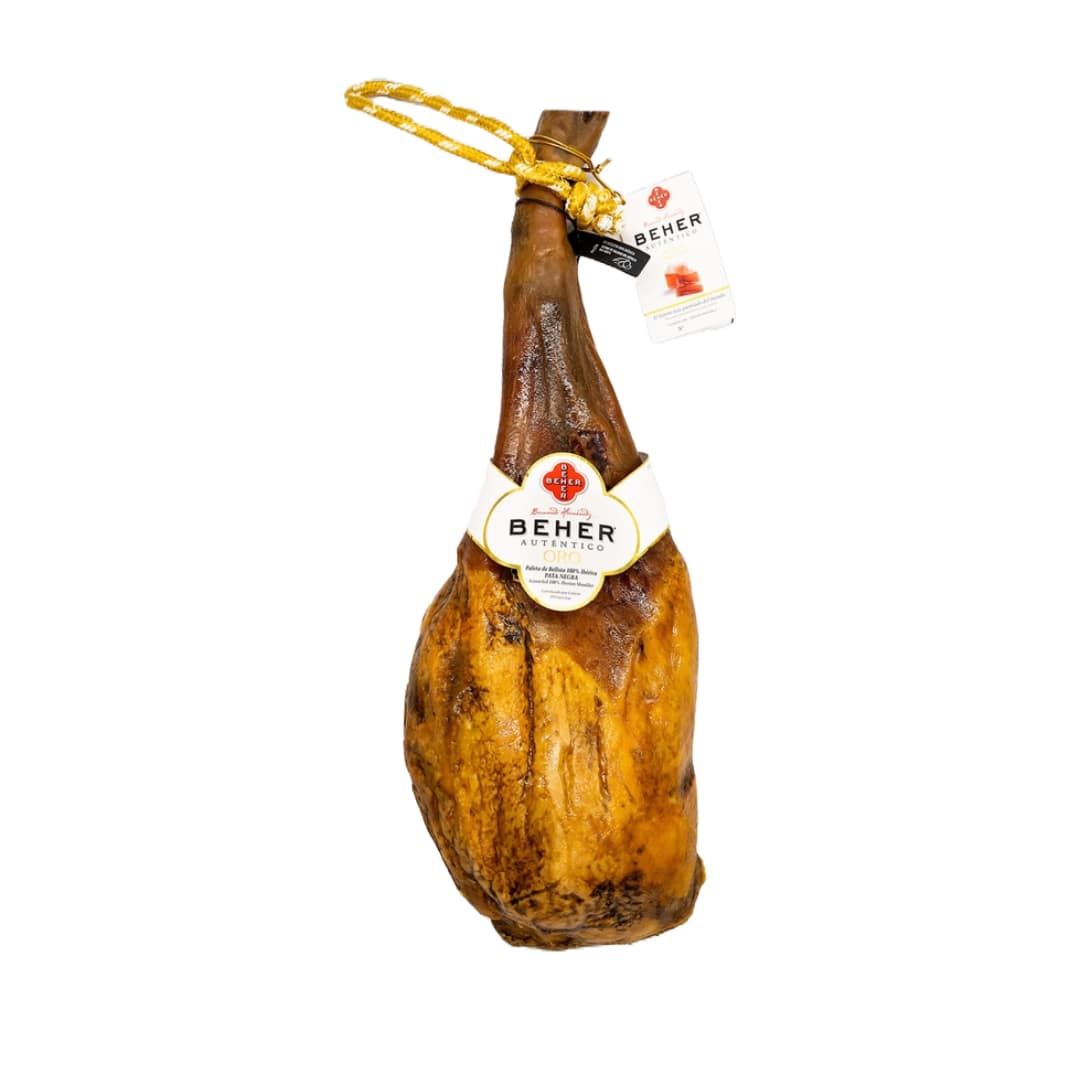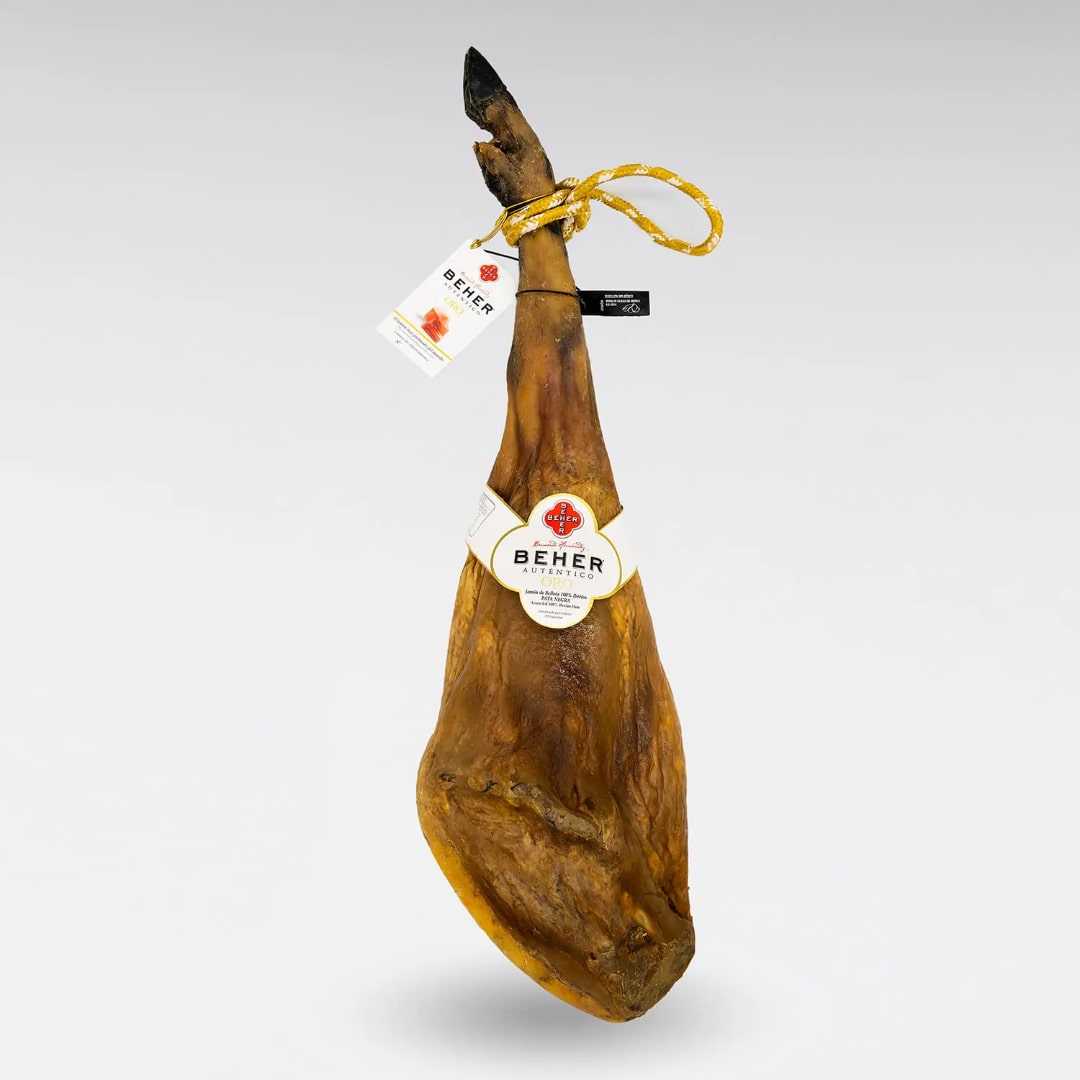14 products
14 products
Sort by:
Discover the Rich Tradition of Spanish Serrano Ham Shoulder
Experience the rich tradition of Spanish cuisine with our Bone-In Serrano Ham Shoulder by Fermin. Crafted using time-honored techniques and sourced from the finest pork, this Serrano ham shoulder offers an exquisite taste that is both authentic and full of character. Each ham is cured for a minimum of 18 months, allowing the flavor to mature and develop its signature savory taste and tender texture. Ideal for adding a touch of Mediterranean flair to any meal, this Serrano ham is a true gem of Spanish gastronomy.
Why Choose Fermin Serrano Ham Shoulder?
- Sourced from Pigs Raised in Salamanca, Spain: Fermin’s Serrano ham shoulder is crafted from pigs raised in Salamanca, a region known for its unique climatic conditions that are ideal for curing Spanish ham.
- Heavier and Fattier Pigs: These pigs are older, heavier, and fattier than their counterparts in Northern Europe, contributing to the superior quality and marbling of the meat.
- 18-Month Curing Process: Each ham shoulder is cured for at least 18 months, allowing the natural flavors to intensify and the marbling to develop, delivering an authentic Serrano flavor.
- Complex Flavor Profile: The result is a rich, savory ham with a firm texture and an intense flavor that sets it apart from other cured meats.
Paleta Serrana vs. Jamón Serrano - What’s the Difference?
Understanding the difference between Paleta Serrana and Jamón Serrano is essential for any cured meat enthusiast:
- Paleta Serrana (Shoulder): The Serrano ham shoulder is cut from the front leg of the pig. It is smaller and contains more bone but offers a more intense flavor. The slightly higher fat content and shorter curing process result in a firmer texture with a concentrated taste.
- Jamón Serrano (Hind Leg): Comes from the back leg of the pig and is typically larger with a longer curing time, producing a milder flavor and softer texture. It is ideal for those who prefer a delicate, less intense ham.
How to Slice Your Bone-In Serrano Ham Shoulder
Slicing your Whole Bone-In Serrano Ham Shoulder is easier than it seems! With the right tools and a bit of practice, you’ll be slicing like a pro in no time. Here’s what you’ll need:
- A Serrano Ham Holder (Jamonero): Keeps the ham stable for safe and precise slicing.
- A Long, Flexible Ham Slicer Knife: Designed to achieve thin, uniform slices that highlight the marbling and texture of the ham.
- A Sharpening Steel: Keeps your blade sharp for clean cuts through the firm meat.
Follow these steps:
- Secure the Ham: Place the ham firmly in the ham holder.
- Start Slicing: Use smooth, steady strokes to slice thin pieces parallel to the bone.
- Serve and Enjoy: Allow the slices to reach room temperature to fully appreciate the rich flavors.
How to Enjoy Fermin Serrano Ham Shoulder
Our Bone-In Serrano Ham Shoulder by Fermin is a versatile ingredient that can be enjoyed in various ways:
- On Its Own: Perfect for savoring the rich flavors directly, slice it thin and serve as a simple yet elegant snack.
- On a Spanish Charcuterie Board: Combine it with Manchego cheese, Spanish olives, and crusty bread for an authentic tapas experience.
- In Recipes: Add to your favorite dishes, such as Spanish omelets, soups, or salads, to elevate the flavor of your meals.
- Paired with Spanish Wines: Enjoy it with a glass of Albariño, Rioja, or Ribera del Duero for a delightful culinary experience.
Key Features of Our Serrano Ham Shoulder
- Authentic Spanish Food: Experience the genuine taste of Spain with every slice.
- Quality Curing Process: Cured for a minimum of 18 months using traditional techniques.
- Perfect for Any Occasion: Ideal for casual gatherings, tapas nights, or as a centerpiece for elegant affairs.
- Versatile Ingredient: Suitable for enjoying on its own or as part of a gourmet dish.
Buy Fermin Bone-In Serrano Ham Shoulder Online in the USA
Ready to experience the authentic taste of Spanish Serrano ham? Order Fermin Bone-In Serrano Ham Shoulder online at Iberico Taste and enjoy fast, secure delivery throughout the USA. Perfect for charcuterie boards, tapas, or as a gourmet gift, this Serrano ham shoulder brings the true flavors of Spain to your home. Discover the depth of flavor and quality that comes with Fermin Serrano Ham Shoulder and elevate your culinary experience today.
Discover the Rich Taste of Fermin’s Whole Bone-In Ibérico Ham Shoulder
Indulge in the exceptional flavor of Fermin’s Whole Bone-In Ibérico Ham Shoulder, a true gem of Spanish cuisine. Sourced from 100% purebred Iberico pigs raised in the lush pastures of La Alberca, Salamanca, these free-range, pasture-raised pigs enjoy a natural diet of grains, grasses, and roots, creating a premium Ibérico pork renowned for its superior marbling and unique flavor profile. Perfect for gourmet enthusiasts and lovers of Spanish cured meats, this Ibérico ham shoulder brings the authentic taste of Spain right to your table.
Why Choose Fermin Whole Bone-In Ibérico Ham Shoulder?
- Sourced from 100% Purebred Iberian Pigs: Raised in the natural environment of La Alberca, these pigs enjoy a free-range lifestyle that enhances the quality and marbling of the meat.
- Traditional Curing in Natural Cellars: Aged for over 24 months using time-honored techniques to achieve its intense, well-balanced flavor.
- High in Oleic Acid and Nutrients: Rich in healthy fats, vitamins, and antioxidants, making it a delicious and nutritious choice.
- All-Natural and Free from Additives: Our Ibérico pork is free from artificial additives, preserving the purity of traditional Spanish food.
A Symphony of Flavor and Texture
Each slice of Fermin’s Ibérico Ham Shoulder reveals a succulent, melt-in-your-mouth texture and a harmonious blend of sweet and savory notes. With hints of nutty acorns and earthy undertones, this ham’s rich, complex flavor profile creates a unique culinary experience that epitomizes the finest in Spanish cured meats. The marbled fat enhances the juiciness and depth of flavor, making it a standout addition to any Spanish charcuterie board or tapas spread.
Traditional Curing Process for Superior Quality
Our Whole Bone-In Ibérico Ham Shoulder is cured for a minimum of 24 months in natural cellars, where it undergoes a meticulous aging process that brings out its intense flavors and tender texture. This traditional method allows the ham to reach its peak quality, resulting in a luxurious Spanish delicacy that embodies the essence of Spanish charcuterie. Each ham is crafted with care, reflecting Fermin’s commitment to excellence and dedication to top-quality Iberico pork.
Health Benefits and Natural Goodness
In addition to its exquisite flavor, Fermin’s Ibérico Ham Shoulder offers numerous health benefits:
- Rich in Oleic Acid: Contains the same heart-healthy fats found in extra virgin olive oil.
- High in Vitamins and Antioxidants: Supports overall health and well-being.
- All-Natural Product: Free from artificial additives, making it a healthy choice for those seeking authentic Spanish food.
How to Slice Your Ibérico Ham Shoulder
Slicing your whole Ibérico ham shoulder is a rewarding experience that allows you to enjoy every bite at its best. With the right tools and a little practice, you’ll be slicing like a pro in no time. Here’s what you’ll need:
- A Sturdy Ham Holder (Jamonero): Keeps the ham stable for safe and precise slicing.
- A Long, Flexible Ham Slicer Knife: Designed for achieving thin, even slices.
- A Sharpening Steel: Keeps your blade sharp for clean cuts through the marbled meat.
Follow these steps:
- Secure the Ham: Place the ham firmly in the ham holder.
- Start Slicing: Use smooth, steady strokes to slice thin pieces parallel to the bone.
- Serve and Enjoy: Allow the slices to reach room temperature to fully appreciate the rich, complex flavors.
Perfect Pairings for an Authentic Spanish Experience
Our Fermin Whole Bone-In Ibérico Ham Shoulder is a versatile addition to any gourmet spread, pairing beautifully with a variety of Spanish foods and drinks. Here are a few pairing suggestions:
- Spanish Cheeses: Pair with Manchego or other artisanal cheeses to complement the ham’s nutty, savory flavors.
- Spanish Wines: Serve with a glass of Rioja, Ribera del Duero, or a fine Sherry to enhance its rich taste.
- Tapas Spread: Include in a tapas selection with Spanish olives, almonds, and crusty bread for an authentic Spanish experience.
Buy Fermin Whole Bone-In Ibérico Ham Shoulder Online in the USA
Ready to experience the true Jamon Iberico taste? Order Fermin Whole Bone-In Ibérico Ham Shoulder online at Iberico Taste and enjoy fast, reliable shipping throughout the USA. Perfect for special occasions, gourmet enthusiasts, or as a luxurious gift, this premium Ibérico ham shoulder is a must-have for those seeking the pinnacle of Spanish gastronomy.
Experience the Authentic Taste of Covap Whole Bone-In Ibérico Ham Shoulder
Indulge in the exquisite flavors of our Whole Bone-In Ibérico Ham Shoulder by Covap, a true masterpiece of Spanish cuisine. Crafted by Covap, one of Spain's most reputable producers of cured meats, this premium Ibérico ham shoulder embodies the rich heritage and authentic tastes of Spain, bringing the flavors of the dehesa and traditional Spanish gastronomy right to your table.
Sourced from Free-Range, 100% Ibérico Pigs in Los Pedroches, Córdoba
Our Covap Whole Bone-In Ibérico Ham Shoulder is sourced from 100% purebred Iberian pigs raised in the lush pastures of Los Pedroches, Córdoba. These free-range pigs roam freely and are nourished on a diverse diet of wild grasses, herbs, acorns, and high-quality grains, resulting in a grass-fed and acorn-fed product that stands out for its superior marbling and unmatched flavor. The combination of pasture-raised and acorn-fed practices ensures a rich, complex flavor profile that is a testament to the highest quality Iberico pork.
A Symphony of Flavor and Texture
Experience a succulent, melt-in-your-mouth texture with every slice of this Iberico shoulder ham. The marbled meat is infused with sweet, nutty notes of acorns, hints of honey, and subtle truffle undertones, creating a harmonious blend of flavors that will captivate your senses. This rich and complex flavor profile makes it a must-have for any connoisseur of Spanish gourmet food.
Traditional 18-Month Aging Process for Unmatched Quality
The Covap Ibérico Ham Shoulder is aged for a minimum of 18 months in natural drying rooms using traditional methods. This meticulous curing process enhances the natural flavors and ensures a superior quality product with a deep, savory taste and melt-in-your-mouth texture. This ham shoulder is an essential addition to any Spanish charcuterie board, adding an authentic touch to your gourmet experience.
Why Choose Covap Whole Bone-In Ibérico Ham Shoulder?
- Sourced from Free-Range, 100% Iberian Pigs: Raised in the dehesa pastures of Los Pedroches, these pigs roam freely, enjoying a natural lifestyle that contributes to the ham’s quality and flavor.
- Unique Grass-Fed and Acorn-Fed Diet: The pigs’ diverse diet of wild grasses, herbs, and acorns results in superior marbling and a rich, nutty flavor.
- Traditional Aging Process: Cured for over 18 months using time-honored techniques, delivering an intense, well-balanced flavor.
- High-Quality, All-Natural Goodness: Rich in vitamins and natural antioxidants, this Iberico ham is free from artificial additives, offering an authentic, all-natural product.
How to Slice Your Covap Whole Bone-In Ibérico Ham Shoulder
Slicing your whole Ibérico ham shoulder is easier than you think! With the right tools and a bit of practice, you can achieve perfect, thin slices that highlight the ham’s superior marbling and flavor. You will need:
- A Sturdy Ham Holder (Jamonero): Keeps the ham stable for precise slicing.
- A Long, Flexible Ham Slicer Knife: Ideal for creating thin, uniform slices.
- A Sharpening Steel: Keep your blade sharp to cut smoothly through the marbled meat.
Follow these steps to slice like a professional:
- Secure the Ham: Place the ham firmly in the ham holder with the hoof facing upwards.
- Start Slicing: Use steady, smooth strokes to slice thin pieces from the top down.
- Serve and Enjoy: Allow the slices to reach room temperature to fully appreciate their rich flavor.
Perfect Pairings for an Authentic Spanish Experience
Our Whole Bone-In Ibérico Ham Shoulder by Covap pairs beautifully with a variety of Spanish foods and drinks, enhancing any gourmet experience. Here are a few pairing ideas:
- Spanish Cheese: Serve with aged Manchego or other artisanal cheeses to complement the ham’s rich flavors.
- Spanish Wine: Pair with a glass of Rioja, Ribera del Duero, or a fine Sherry for a perfect match.
- Tapas Selection: Include in a tapas platter with olives, crusty bread, and extra virgin olive oil to create an authentic Spanish experience.
Buy Covap Whole Bone-In Ibérico Ham Shoulder Online in the USA
Ready to bring the luxurious flavors of Spain to your home? Order Covap Whole Bone-In Ibérico Ham Shoulder online at Iberico Taste and enjoy fast, reliable shipping across the USA. Ideal for special occasions, gourmet enthusiasts, or as a luxurious gift, this premium Iberico ham shoulder is a must-have for anyone seeking the finest in Spanish food.
Bone-In Ibérico Ham Shoulder Bellota Pata Negra by Fermin – A Culinary Masterpiece
Our Bone-In Ibérico Ham Shoulder Bellota Pata Negra by Fermin is an exceptional product originating from the front leg of free-range, 100% Iberian pigs, a cherished native breed from Spain renowned for its superior quality. During the Montanera season, from October to February, these pigs undergo a remarkable transformation, doubling their weight as they feast on a diet rich in acorns and grass in the dehesa, resulting in the finest and most prestigious shoulder in the world.
Cured for a minimum of 26 months using artisanal methods in La Alberca, Spain, a Natural Reserve declared a World Heritage site, this Bellota Ham Shoulder embodies the epitome of gourmet excellence.
A masterpiece of Spanish cured meats, it is rich in protein and omega-3 fatty acids.
What Do I Need for Slicing?
Despite what you may think, slicing a ham leg is not difficult. All you need is a ham holder, a special ham carving knife, and a bit of practice, that's it!
Shoulder vs Ham
The Shoulder comes from the front leg of the pig. It is smaller, with less fat and more bone. Its flavor is less juicy but more intense compared to the ham, which comes from the hind leg.
This whole Bone-In Ibérico Ham Shoulder Bellota Pata Negra crafted by Covap, has a rich and succulent flavor. Sourced from free-range 100% Iberian pigs raised in the pristine dehesa, fed with a natural diet based on acorns.
Each piece undergoes an extensive aging process in our own natural cellars for a minimum of 18 months. This ensures its excellent flavor and intense aroma, accentuated by the characteristic marbling resulting from the pigs' acorn-based diet.
Ideal for lovers of premium Spanish cured meats, each bite of this Iberico Ham Leg is a true delight that captures the essence of Spain's culinary heritage!
What do I need for slicing?
Despite what you might think, slicing a ham leg is not difficult. All you need is a ham holder, a special ham slicer knife, and a bit of practice, that's it!
Ham Shoulder vs Ham
The ham shoulder is the front leg of the pig. It is smaller, with less fat and more bone. Its flavor is less juicy but more intense.
Discover the Exquisite Taste of Cinco Jotas Bone-In Ibérico Ham Shoulder
Experience the luxurious flavor of the Whole Bone-In Ibérico Ham Shoulder Bellota crafted by Cinco Jotas (5J), one of Spain’s most internationally renowned producers of Iberico ham. Sourced from 100% purebred Iberian pigs raised in the dehesa, this Paleta Ibérica de Bellota is a true delicacy that captures the essence of Spanish gourmet tradition. These acorn-fed pigs roam freely and enjoy a free-range lifestyle, resulting in a ham shoulder that is rich in oleic acid and features the distinctive marbled texture and complex nutty flavors of the finest Iberico pork.
Why Choose Cinco Jotas Bone-In Ibérico Ham Shoulder?
- 100% Purebred Iberian Pigs: Sourced from the best Iberian pigs, raised in the natural pastures of the dehesa.
- Acorn-Fed During Montanera Season: The pigs follow a montanera diet of acorns and natural grasses, which enhances the flavor and infiltrates the muscle with high-quality fat.
- Rich in Oleic Acid: Contains the same heart-healthy fats found in olive oil, contributing to the ham’s melt-in-your-mouth texture.
- Supreme Quality: The marbled fat and tender meat create a unique experience that melts on the palate, leaving a lingering, savory finish.
Paleta Ibérica vs. Jamón Serrano - What’s the Difference?
Understanding the difference between Paleta Ibérica and Jamón Serrano is key to appreciating their unique qualities:
- Paleta Ibérica de Bellota: This ham shoulder is sourced from acorn-fed Iberian pigs. The Paleta (shoulder) has a smaller size and a higher fat content, giving it a rich, juicy flavor and melt-in-your-mouth texture. Its shorter curing process makes it slightly more intense in flavor compared to a full Jamón Ibérico.
- Jamón Serrano: Typically sourced from white pig breeds, this ham comes from the hind leg and has a firmer, less marbled texture. The Serrano shoulder is leaner and has a more straightforward flavor compared to the complexity of Paleta Ibérica.
How to Slice Cinco Jotas Whole Bone-In Ibérico Ham Shoulder
Slicing a whole Paleta Ibérica may seem challenging, but with the right tools and some practice, it becomes an enjoyable experience. For best results, you will need:
- A Ham Holder (Jamonero): Keeps the shoulder stable for safe and precise slicing.
- A Long, Flexible Ham Slicer Knife: Ideal for achieving thin, even slices that showcase the marbling and texture.
- A Sharpening Steel: Keep your knife sharp to cut smoothly through the marbled meat.
With these tools, you’ll be able to slice like a professional and enjoy every bit of your Cinco Jotas Ibérico Ham Shoulder.
Flavor and Texture - A Gourmet Experience
The flavor of Cinco Jotas Paleta Ibérica de Bellota is a symphony of sweet, nutty notes with a delicate balance of savory and earthy undertones. The marbled fat melts effortlessly, releasing the rich flavors with each bite and delivering an intense and lingering taste experience. Its unique nutty aroma and silky texture make it an exquisite addition to any gourmet spread.
Perfect for Tapas, Charcuterie Boards, and Gourmet Cooking
This Cinco Jotas Bone-In Ibérico Ham Shoulder is perfect for creating authentic Spanish tapas or as the centerpiece of a charcuterie board. Serve it with Manchego cheese, Spanish olives, and a glass of Rioja red wine to bring out its rich, complex flavors. Its melt-in-your-mouth texture and unique taste make it a versatile ingredient for gourmet dishes or as a highlight of any celebration.
Buy Cinco Jotas Bone-In Ibérico Ham Shoulder Online in the USA
Ready to experience the true Jamon Iberico taste? Order Cinco Jotas Whole Bone-In Ibérico Ham Shoulder online at Iberico Taste and enjoy fast, secure delivery throughout the USA. Perfect for Spanish charcuterie boards, tapas nights, or as a gourmet gift, this Paleta Ibérica de Bellota brings the authentic flavors of Spain’s dehesa right to your table. Discover why Cinco Jotas (5J) is one of the top brands for Iberico pork and enjoy a true Spanish delicatessen today.
Discover the Traditional Taste of Spanish Jamón Serrano
Experience the rich flavor of Spanish Jamón Serrano by Fermin, the most iconic Spanish cured meat. Carefully crafted from premium Serrano pork, this ham is cured and aged to perfection, following time-honored methods that have made Jamón Serrano a staple in Spanish cuisine. Known as the classic among classics, each slice of this Serrano ham offers a delightful blend of savory and mild flavors, with a smooth, melt-in-your-mouth texture that makes it perfect for any occasion.
Why Choose Fermin Jamón Serrano?
- Crafted from Premium Serrano Pork: Made from the highest quality white pig breeds, such as Duroc and Large White, ensuring superior flavor and texture.
- Traditional Curing Process: Expertly cured and aged to perfection by Fermin, following Spanish traditions for an authentic Jamón Serrano taste.
- Nutritional Benefits: Rich in minerals and high in protein, this Spanish ham is an excellent source of nutrients essential for muscle and brain health.
Jamón Serrano vs. Jamón Ibérico - What’s the Difference?
Understanding the differences between Jamón Serrano and Jamón Ibérico is key to choosing the right ham for your needs:
- Jamón Serrano: Sourced from white pig breeds like Duroc, this ham is cured primarily with salt, resulting in a mild flavor with a firmer texture. It has a shorter curing time compared to Jamón Ibérico, making it a versatile choice for those who enjoy a lighter, more straightforward taste.
- Jamón Ibérico: Made from purebred Iberico pigs, known for their unique ability to infiltrate fat into the muscle. These hams are often acorn-fed and raised in the dehesa, giving them a richer, more complex flavor and a delicate, marbled texture that melts in your mouth. The longer curing process also contributes to its superior quality and intense taste.
How to Slice Your Jamón Serrano
Slicing your whole Serrano ham leg is easier than it seems with the right tools and a little practice. For the best results, you will need:
- A Serrano Ham Holder: Keeps the ham stable and secure during slicing.
- A Special Ham Carving Knife: Use a long, flexible knife designed specifically for slicing ham thinly and evenly.
- A Sharpening Steel: Keep your blade sharp to achieve clean cuts through the ham.
With the proper equipment and a bit of patience, you’ll be slicing your Spanish Serrano ham like a pro.
Flavor and Texture - A True Spanish Classic
The flavor of Fermin Jamón Serrano is characterized by its mild, savory notes, and a gentle sweetness that balances perfectly. The shorter curing process preserves the natural flavors of the pork, while the expert aging gives it a firm yet tender texture. This Spanish Serrano ham is perfect for enjoying on its own, served as part of a charcuterie board, or paired with crusty bread, Spanish olives, and Manchego cheese.
Perfect for Charcuterie Boards, Tapas, and Everyday Enjoyment
Our Spanish Jamón Serrano by Fermin is ideal for creating authentic Spanish tapas or adding to your charcuterie board. Pair it with Spanish olives, aged cheeses, and a glass of Tempranillo or Rioja red wine to experience its full flavor. Its mild, approachable taste makes it a versatile option for everyday enjoyment, whether served thinly sliced or cut into small cubes.
Buy Authentic Spanish Jamón Serrano Online in the USA
Ready to enjoy the true taste of Spanish Jamón Serrano? Order Fermin Jamón Serrano online at Iberico Taste and have it delivered directly to your home in the USA. Perfect for charcuterie boards, Spanish tapas, or as a gourmet gift, this classic Serrano ham brings the authentic flavors of Spain right to your table.
Discover the Exquisite Taste of Fermin Whole Bone-In Ibérico Ham
Our Whole Bone-In Ibérico Ham by Fermin is crafted from 100% purebred Iberian pigs, a breed renowned for its unique ability to store healthy fat, resulting in a beautifully marbled texture that enhances both flavor and tenderness. Raised in free-range conditions, these pigs enjoy a natural diet of grains, grasses, roots, and herbs, contributing to the highest quality of this Iberico ham. Cured for a minimum of 34 months using traditional methods in La Alberca, a region in Spain known for its pristine environment and declared a Natural Reserve and World Heritage Site, each ham leg offers an exceptional Jamon Iberico taste experience.
Why Choose Fermin Whole Bone-In Ibérico Ham?
- 100% Purebred Iberian Pigs: Sourced from the finest Iberico pork, bred for its superior quality and rich flavor.
- Free-Range Lifestyle: Pigs roam freely, enjoying a natural diet that enhances the flavor profile and marbling of the meat.
- Long, Natural Curing Process: Cured for over 34 months using artisanal methods in La Alberca, a region renowned for producing top-quality Spanish hams.
- Unparalleled Flavor and Texture: The marbled fat melts gently into the muscle, creating a succulent, melt-in-your-mouth texture.
Grain-Fed Jamón Ibérico de Cebo vs. Acorn-Fed Jamón Ibérico de Bellota
Understanding the differences between Jamón Ibérico de Cebo and Jamón Ibérico de Bellota is key to choosing the right ham for your needs:
- Jamón Ibérico de Cebo: This type of Iberico ham comes from pigs that are mainly fed on cereals and grains. It has a delicious, savory flavor but with less complexity compared to Bellota. Ideal for those looking for a high-quality Iberico ham with a leaner profile.
- Jamón Ibérico de Bellota: Made from acorn-fed pigs that roam freely during the montanera season. This diet results in a more intense flavor, with sweet, nutty notes and a marbled texture that melts in your mouth, delivering a richer, more tender experience.
How to Slice Your Whole Bone-In Ibérico Ham?
Slicing a whole Iberico ham leg is easier than it looks with the right tools and a little practice. To achieve the perfect thin slices, you will need:
- A Ham Holder (Jamonero): Provides stability and safety during slicing.
- A Long, Flexible Ham Slicer Knife: Ideal for achieving thin, precise slices.
- A Sharpening Steel: Keep your blade sharp for clean cuts through the marbled meat.
With a bit of practice and the right setup, you’ll be slicing like a pro and enjoying your Iberico ham in no time.
Flavor and Texture - A True Gourmet Experience
The flavor of Fermin Whole Bone-In Ibérico Ham is rich and complex, combining savory, nutty, and earthy notes with hints of natural herbs and grains from the pigs’ diet. The marbled fat creates a juicy, velvety texture that melts delicately on the palate, leaving a long-lasting, unforgettable taste. This Spanish cured ham is perfect for enjoying on its own, as part of a charcuterie platter, or in a variety of gourmet dishes.
Perfect for Charcuterie Boards and Gourmet Tapas
Whether served as the centerpiece of a Spanish charcuterie board or paired with Manchego cheese, olives, and a glass of Rioja red wine, Fermin Whole Bone-In Ibérico Ham offers a sophisticated addition to any meal. Its rich, complex flavor also makes it an ideal ingredient for gourmet recipes, adding depth and elegance to your cooking.
Buy Fermin Whole Bone-In Ibérico Ham Online in the USA
Ready to experience the authentic Jamon Iberico taste? Order Fermin Whole Bone-In Ibérico Ham online at Iberico Taste and enjoy fast, secure delivery throughout the USA. Perfect for charcuterie boards, Spanish tapas, or as a gourmet gift, this premium Iberico ham brings the authentic flavors of Spain’s natural reserves to your table. Discover why Fermin is recognized as a top brand for Iberico pork and enjoy the finest quality Spanish ham today.
Discover the Exquisite Taste of Covap Whole Bone-In Ibérico Ham
Indulge in the rich flavor of Covap Whole Bone-In Ibérico Ham, crafted from 100% purebred Iberian pigs raised in free-range conditions. These pigs are nourished on a diet of natural dehesa resources, supplemented with high-quality feed to create a gourmet Spanish ham that boasts unparalleled depth and complexity. Each slice of this Iberico ham offers a delicate balance of savory and nutty sweetness, with a melt-in-your-mouth texture that is truly unforgettable. Handcrafted and aged to perfection by Covap, this Jamón Ibérico will elevate any charcuterie board or Spanish tapas spread.
Why Choose Covap Whole Bone-In Ibérico Ham?
- 100% Purebred Iberian Pigs: Sourced from the finest purebred pigs, known for their superior quality and marbling.
- Free-Range Lifestyle: Raised in the dehesa, these pigs enjoy a natural environment that enhances the flavor and texture of the meat.
- Nourished on Natural Resources: The diet consists of natural herbs, grasses, and high-quality feed, contributing to the ham’s complex flavor profile.
- Handcrafted by Covap: Aged naturally using traditional methods, each leg is carefully monitored to achieve its signature richness and aromatic qualities.
Jamón Ibérico de Cebo vs. Jamón Ibérico de Bellota
Understanding the difference between Jamón Ibérico de Cebo and Jamón Ibérico de Bellota is key to appreciating the Jamon Iberico taste:
- Jamón Ibérico de Cebo: Sourced from pigs fed primarily on cereals and grains, this ham has a simpler, pleasant flavor with a leaner texture. Ideal for those who enjoy a lighter, more subtle taste.
- Jamón Ibérico de Bellota: Comes from acorn-fed pigs that roam freely during the montanera season, feeding on acorns and natural pastures. This diet results in a richer, more intense flavor, with marbled fat that melts into the muscle, making the ham exceptionally tender and aromatic.
Flavor and Texture - A True Gourmet Experience
Each slice of Covap Whole Bone-In Ibérico Ham offers a symphony of flavors, combining savory, sweet, and nutty notes. The meat’s marbled texture creates a juicy, velvety mouthfeel, while the high-quality fat content allows the flavors to unfold gradually, leaving a lingering, unforgettable taste. This Spanish cured ham is perfect for enjoying on its own or as part of a charcuterie platter, showcasing the highest quality Iberico pork.
What Do I Need for Slicing a Whole Bone-In Iberico Ham?
Slicing a whole Iberico ham leg is easier than it looks. To get perfect thin slices that highlight the ham’s flavor and texture, you will need:
- A Ham Holder (Jamonero): Provides stability and safety during slicing.
- A Long, Flexible Ham Slicer Knife: The ideal tool for achieving thin, precise slices.
- A Sharpening Steel: Keep your blade sharp to cut smoothly through the marbled meat.
With the right tools and a bit of practice, you’ll be slicing like a pro in no time.
Perfect for Charcuterie Boards and Gourmet Tapas
Whether served as the centerpiece of a Spanish charcuterie board or enjoyed on its own, Covap Whole Bone-In Ibérico Ham pairs beautifully with Manchego cheese, olives, and a glass of Tempranillo or Rioja red wine. Its rich, complex flavor makes it a versatile addition to gourmet dishes or as an authentic Spanish tapa for special occasions.
Buy Covap Whole Bone-In Ibérico Ham Online in the USA
Ready to experience the true Jamon Iberico taste? Order Covap Whole Bone-In Ibérico Ham online and enjoy fast, secure delivery throughout the USA. Perfect for charcuterie boards, Spanish tapas, or as a gourmet gift, this premium Iberico ham brings the authentic flavors of Spain’s dehesa to your table. Discover why Covap is one of the top brands for Iberico pork and enjoy the finest Spanish ham today.
Discover the Exquisite Taste of Fermin Whole Jamón Ibérico de Bellota
Our Whole Jamón Ibérico de Bellota by Fermin is sourced from 100% purebred Iberian pigs, known as Pata Negra, raised freely in the dehesa woodlands of Spain. These acorn-fed pigs develop the highest quality marbling and a distinctive flavor profile that makes this Iberico ham one of the greatest treasures of Spanish gastronomy. Cured for an extended period using traditional methods, this Jamón Ibérico boasts an exceptional texture and complex, nutty flavors that are deeply influenced by its free-range lifestyle and acorn-rich diet during the montanera season.
Why Choose Fermin Whole Jamón Ibérico de Bellota?
- 100% Purebred Iberico Pigs: Sourced from purebred Iberian pigs, raised in the natural dehesa of Spain.
- Acorn-Fed During Montanera: The pigs are fed a diet of sweet acorns, which infuses the meat with a unique, nutty flavor and enhances the marbled texture.
- Traditional Curing Process: The ham is aged naturally, developing its signature rich taste and melt-in-your-mouth tenderness.
- Nutritional Benefits: Rich in proteins and omega-3 fatty acids, this Jamón de Bellota is a healthy indulgence that aligns with the Mediterranean diet.
Flavor and Texture - A Gourmet Experience
The flavor of Fermin Jamón Ibérico de Bellota is a harmonious blend of sweet and savory notes, with hints of acorns and herbs from the pigs’ natural diet. The velvety texture melts delicately on the palate, delivering a burst of complex flavors with every bite. Its marbled fat creates a succulent, creamy mouthfeel that is unlike any other ham, making it a true delicacy for discerning palates.
What Do I Need for Slicing a Whole Jamón Ibérico?
Slicing a whole Iberico ham is easier than it seems. To achieve the perfect thin slices that reveal the full flavor and texture, you will need:
- A Ham Holder (Jamonero): Provides stability and safety during slicing.
- A Long, Flexible Ham Slicer Knife: Ideal for achieving thin, precise slices.
- A Sharpening Steel: Keep your blade sharp for clean cuts through the marbled meat.
With a little practice and the right tools, you’ll be slicing like a pro and enjoying your Iberico ham in no time.
Perfect for Charcuterie Boards, Tapas, and Gourmet Cooking
This Whole Jamón Ibérico de Bellota is perfect for creating authentic Spanish tapas or elevating your charcuterie board. Serve it with Manchego cheese, Spanish olives, and a glass of Tempranillo or Rioja red wine to fully appreciate its rich flavors. The versatility of this ham also makes it an ideal addition to gourmet dishes, adding depth and complexity to any meal.
Nutritional Benefits of Fermin Whole Jamón Ibérico de Bellota
In addition to its exquisite taste, Fermin Jamón Ibérico de Bellota is packed with essential nutrients:
- High in Omega-3 Fatty Acids: Contains the same heart-healthy fats found in olive oil, which support cardiovascular health.
- Rich in Protein: Provides a high-quality source of protein, essential for muscle maintenance and repair.
- Low in Saturated Fat: A healthy indulgence that complements the Mediterranean diet.
Buy Fermin Whole Jamón Ibérico de Bellota Online in the USA
Ready to experience the true Jamon Iberico taste? Order Fermin Whole Jamón Ibérico de Bellota online at Iberico Taste and enjoy fast, secure delivery throughout the USA. Perfect for charcuterie boards, Spanish tapas, or as a centerpiece for special occasions, this Pata Negra ham will bring the authentic flavors of Spain right to your table. Discover why Fermin is recognized as a top brand for Iberico ham and enjoy the finest acorn-fed Iberico pork today.
Discover the Exquisite Taste of Covap Bone-In Ibérico Ham Bellota Pata Negra
Our Bone-In Ibérico Ham Bellota Pata Negra by Covap is a true culinary masterpiece crafted from 100% purebred Iberico pigs. Sourced from free-range Iberian pigs raised in the dehesa woodlands, this acorn-fed Iberico ham is the pinnacle of highest quality Spanish cured meats. Aged naturally for over 36 months in traditional drying houses, each leg embodies the rich, nutty flavors that make Jamon Iberico de Bellota one of the world’s most finest delicacies. Its marbled texture and vibrant red color are a testament to the perfect balance between lean meat and melt-in-your-mouth fat, offering an unforgettable Jamon Iberico taste experience.
Why Choose Covap Bone-In Ibérico Ham Bellota Pata Negra?
- 100% Purebred Iberico Pigs: Carefully selected for their racial purity, these pigs are bred for superior quality and flavor.
- Free-Range Lifestyle in the Dehesa: Raised in the natural pastures of Spain, these pigs roam freely, feeding on acorns, grasses, and herbs.
- Acorn-Fed During the Montanera Season: The natural diet of acorns enhances the ham’s flavor, infusing the meat with sweet and earthy notes.
- Meticulous Curing Process: Aged for over 36 months in natural drying sheds, this ham develops an intense flavor profile with complex layers.
- Award-Winning Quality: Winner of the “Superior Taste Award” for five consecutive years, showcasing its top-tier quality and unparalleled flavor.
Flavor Profile - A Symphony of Sweet and Savory Notes
The flavor of Covap Bone-In Ibérico Ham Bellota is rich and complex, combining the sweetness of acorns with earthy undertones, subtle hints of truffle, and a delicate balance of honey and savory notes. Its marbled fat creates a tender texture that melts in your mouth, releasing a burst of flavors with each bite. This Pata Negra ham offers a true taste of Spain, echoing the natural essence of the dehesa and the acorns that form the core of its free-range pigs’ diet.
How to Slice Covap Bone-In Ibérico Ham?
To fully enjoy the Jamon Iberico taste of this Bone-In Ibérico Ham, proper slicing is essential. You will need:
- A Sturdy Ham Holder (Jamonero): Securely hold the ham in place for precise slicing.
- A Long, Flexible Ham Slicer Knife: The ideal tool for achieving thin, uniform slices.
- A Sharpening Steel: Keep your blade sharp for clean cuts through the marbled meat.
With a little practice, you can easily carve perfect slices that showcase the delicate marbling and deep flavor of this exceptional ham.
Nutritional Benefits of Covap Bone-In Ibérico Ham
This acorn-fed Iberico ham is not only a gourmet delicacy but also a healthy addition to your diet. Packed with essential fatty acids, antioxidants, and high-quality proteins, it aligns seamlessly with the principles of the Mediterranean diet:
- Rich in Oleic Acid: The same healthy fat found in olive oil, which supports heart health.
- High in Antioxidants: Helps fight free radicals and supports overall health.
- Excellent Source of Protein: Contributes to muscle maintenance and repair.
Why Covap Ibérico Ham Bellota Is Unique
The uniqueness of Covap Bone-In Ibérico Ham Bellota Pata Negra lies in its careful breeding, natural lifestyle, and meticulous curing process. Each leg is sourced from purebred Iberico pigs, raised in the dehesa and fed a diet of sweet acorns during the montanera season, which enhances the marbled texture and intense flavor. The result is a luxurious ham with a rich, complex taste that’s recognized around the world for its highest quality.
Buy Covap Bone-In Ibérico Ham Bellota Online in the USA
Ready to taste one of the finest Iberico hams? Order Covap Bone-In Ibérico Ham Bellota Pata Negra online at Iberico Taste and enjoy fast, secure delivery throughout the USA. Perfect for charcuterie boards, Spanish tapas, or as a centerpiece for special occasions, this acorn-fed Iberico ham brings the authentic taste of Spain right to your table. Discover why Covap is one of the top brands for Jamon Iberico taste.
Discover the Exquisite Taste of Cinco Jotas Whole Bone-In Ibérico Ham Bellota
Indulge in the luxurious flavor of our Whole Bone-In Ibérico Ham Bellota Pata Negra by Cinco Jotas, made from 100% purebred Iberian pigs and sourced directly from Jabugo, Spain’s premier region for Iberico pork. Raised in the dehesa woodlands during the montanera season and fed a natural diet of sweet acorns, these pigs develop a unique marbled texture and a complex, nutty flavor. This acorn-fed Iberico ham is cured to perfection, resulting in a finest quality product that offers a truly exceptional Jamon Iberico taste.
Why Choose Cinco Jotas Ibérico Ham Bellota?
- Sourced from Jabugo: Renowned for its highest quality Iberico products, Jabugo is known worldwide for producing the finest Spanish hams.
- 100% Purebred Iberian Pigs: Raised in the dehesa with free-range practices, these pigs roam freely and follow a natural lifestyle that enhances their flavor.
- Acorn-Fed During Montanera: The pigs are fed acorns during the montanera period, infusing the fat with a distinct nutty flavor that melts in your mouth.
- 5J - A Top Brand for Iberico Ham: Cinco Jotas (5J) is considered one of the top brands for Jamón Ibérico, ensuring that each ham leg is of the highest quality.
How to Slice Your Whole Bone-In Ibérico Ham Bellota?
Despite what you might think, slicing a whole Iberico ham leg is easier than it seems! With the right tools and a little patience, you’ll be slicing like a pro. Make sure you have:
- A Sturdy Ham Holder (Jamonero): Provides stability and safety during slicing.
- A Long, Flexible Ham Slicer Knife: Ideal for achieving thin, precise slices.
- A Sharpening Steel: Keep your blade sharp for clean cuts through the marbled meat.
With these tools, you can fully enjoy the authentic Jamon Iberico taste and present your ham in the most elegant way.
Perfect for Tapas, Charcuterie Boards, and Gourmet Dishes
Our Cinco Jotas Whole Bone-In Ibérico Ham Bellota is perfect for creating authentic Spanish tapas, serving as part of a gourmet charcuterie board, or adding depth of flavor to your favorite dishes. Pair it with Manchego cheese, Spanish olives, and a glass of red wine to savor the rich flavors of the finest Iberico pork. Whether served alone or as a highlight of a festive meal, each slice delivers the signature Jamon Iberico taste that has made Cinco Jotas famous.
Buy Whole Bone-In Ibérico Ham Bellota by Cinco Jotas Online in the USA
Ready to experience the true taste of Pata Negra? Order Cinco Jotas Whole Bone-In Ibérico Ham Bellota online and enjoy quick delivery throughout the USA. Perfect for special occasions, family gatherings, or as a gourmet gift, this acorn-fed Iberico ham from Jabugo brings the authentic flavors of Spain’s dehesa right to your table. Discover why Cinco Jotas is recognized worldwide as a top brand for Iberico ham.
BEHER Bone-In 100% Ibérico Bellota Shoulder Ham – Gold Label Pata Negra
Experience the authentic taste of Spain with the BEHER Gold Label Ibérico Shoulder Ham, made from 100% purebred Ibérico pigs raised free-range in the dehesas and fed on acorns during the montanera season.
Why Choose BEHER’s 100% Ibérico Bellota Shoulder?
- Pata Negra Quality: Certified 100% purebred Ibérico pigs.
- Free-Range Lifestyle: Raised in the dehesa woodlands, roaming freely in Jabugo and other top regions.
- Montanera Diet: Fed on acorns, grasses, and herbs for exceptional marbling and flavor.
- Artisanal Curing: Slow-cured using traditional methods to preserve flavor and nutrients.
- Healthy Choice: Rich in oleic acid, protein, B1 and E vitamins, iron, and zinc.
Organoleptic Profile
- Appearance: Deep cherry-red meat with golden marbled fat.
- Aroma: Intense and complex, with hints of acorns and mountain herbs.
- Flavor: Sweet and balanced, with a juicy texture and lingering aftertaste.
Pairing Suggestions
- Pair with aged Manchego or Garrotxa cheese.
- Enjoy with Ribera del Duero, Rioja, or dry sherry.
- Serve with crusty artisan bread and Spanish extra virgin olive oil.
- Complement with fresh figs, melon, or pears.
Packaging & Storage
Each shoulder ham comes wrapped in a cotton cover and placed in a premium designer box, ideal for gifting or gourmet displays. Store in a cool, dry place.
Buy BEHER Pata Negra Ham Online in the USA
Shop the BEHER Bone-In 100% Ibérico Bellota Shoulder Ham now at Ibérico Taste. Fast, secure shipping from Miami to all U.S. states. Taste the most awarded Pata Negra ham in the world and bring a piece of Spain to your table.
BEHER Bone-In 100% Ibérico Bellota Ham – Gold Label Pata Negra
The Most Awarded Jamón Ibérico in the World
Experience true Spanish excellence with BEHER’s Bone-In 100% Ibérico Bellota Ham, Gold Label. Recognized as the world’s most awarded Pata Negra ham, this masterpiece is made from free-range Ibérico pigs fed on acorns during the montanera season and raised in the dehesas of Jabugo and Guijuelo.
Why Choose BEHER 100% Ibérico Bellota Ham?
- Pata Negra Quality: From purebred 100% Ibérico pigs raised free-range on oak forests.
- Acorn-Fed Excellence: Fed on acorns, grass, and wild herbs during montanera.
- Traditional Curing: Naturally aged for over 36 months using artisanal methods.
- Exceptional Marbling: Juicy texture and nutty flavor thanks to rich intramuscular fat.
- Limited Selection: Gold Label hams are numbered and chosen from the best pieces.
Flavor Profile & Pairings
This bone-in 100% Ibérico Bellota ham offers an intense yet balanced flavor, with notes of hazelnuts, wild herbs, and a melt-in-your-mouth texture. Best enjoyed at room temperature.
- Wine: Pair with Rioja, Ribera del Duero, or dry Sherry.
- Cheese: Aged Manchego, Payoyo, or Mahón curado.
- Accompaniments: Rustic bread, Arbequina olives, or Marcona almonds.
Elegant Presentation
This premium ham comes in a cotton cover and designer box—perfect for gourmet gifts or centerpiece charcuterie displays. Store in a cool, dry place or refrigerate (36–44°F).
Buy Bone-In 100% Ibérico Bellota Ham by BEHER – Fast Shipping in the USA
Order now at Ibérico Taste and enjoy the highest quality Pata Negra ham, imported directly from Spain. Fast and reliable shipping available across the USA.
Buy Whole Bone-In Spanish Ham – Jamón Ibérico & Serrano
If you've ever dreamed of having a whole leg of Jamón Ibérico or Serrano ham at home, this is your chance. Whether for a big celebration, the holidays, or simply to slice off a tapa whenever you want—nothing compares to the experience of having a bone-in Spanish ham on the stand, ready to carve.
We offer a curated selection of whole bone-in ham legs from Spain’s most respected producers, including 5J Cinco Jotas, Fermín, Beher, and more. Choose from acorn-fed Jamón Ibérico de Bellota, 100% Ibérico ham, or a premium Jamón Serrano.
Buy Spanish bone-in ham legs online with U.S. shipping. We use protective packaging and fast delivery to guarantee freshness and quality from Spain to your home.
Whole Iberico and Serrano Ham Legs – FAQs
The shelf life of a whole bone-in ham can vary significantly based on several factors, including the type of ham, storage conditions, and whether it's been opened or not. Generally, a properly stored whole bone-in Iberico or Serrano ham can last for up to a year or even longer if kept in a cool, dry place. However, once sliced, the ham should be consumed within a few weeks to enjoy its optimal flavor and quality. Here are some tips on storage:
Store the ham in a cool environment, away from direct sunlight.
Wrap any exposed cut surface with kitchen paper to retain moisture.
Use a breathable cloth for wrapping to keep air circulation.
Iberico and Serrano hams are two distinct products of Spanish heritage, each with unique characteristics. The primary differences include:
- Type of Pig: Iberico ham is sourced from Iberico pigs, while Serrano ham comes from white or "Serrano" pigs.
- Feeding Practices: Iberico pigs are often acorn-fed, especially in the case of Iberico Bellota, giving it a richer flavor. In contrast, Serrano pigs are typically fed grains and other cereals.
- Curing Time: Iberico ham undergoes a longer curing process, usually lasting over 24 months, resulting in a more complex flavor compared to Serrano ham, which is generally cured for 12 to 24 months.
Ham is derived from the hind legs of the pig, while the Ham Shoulder, known as "paletilla" in Spanish, comes from the front legs. The term "paletilla" is anatomically appropriate, as it designates the front portion of the animal. Hams are typically longer, reaching up to 90 centimeters, whereas paletillas are shorter, usually between 60 and 75 centimeters.
In terms of width, hams are broader and rounder compared to the more slender paletillas. Naturally, these size differences impact their weight; paletillas average around 5 kilograms, while hams generally weigh between 7 and 8 kilograms, often exceeding that.
In terms of flavor differences, Ham offers a more diverse and complex flavor profile, making it ideal for seasoned tasters of Iberico products. On the other hand, Ham Shoulder presents a bolder, more straightforward taste due to its different curing time.
Selecting the right ham depends on personal preference and the intended use. Consider the following:
- Flavor Preference: If a rich, intense flavor is desired, Iberico ham, particularly the Bellota variety, is an excellent choice. For a milder taste, Serrano ham may be preferred.
- Budget: Iberico hams tend to be more expensive due to the specific breed and feeding practices. Serrano hams are usually more budget-friendly, making them accessible for regular use.
- Occasion: For special occasions or gourmet experiences, Iberico ham is often favored, while Serrano ham works well for casual gatherings or everyday consumption.
Proper storage and preservation techniques are essential for maintaining the quality and flavor of Iberico and Serrano hams. Understanding how to wrap, store, and preserve these hams ensures that their unique characteristics are retained for as long as possible.
- Wrapping and Storing
Effective wrapping and storage are crucial to prolonging the lifespan of whole bone-in ham legs. The way a jamón is wrapped can significantly impact its flavor and texture over time.
Use Cheesecloth or Butcher Paper: Wrapping the ham in cheesecloth or butcher paper allows it to breathe while protecting it from dust. Avoid plastic wrap, as it traps moisture and can lead to deterioration.
Hang the Ham: If possible, hanging the ham in a cool, dry place is ideal. This keeps air circulation optimal and minimizes the chance of moisture buildup.
Store in a Cool, Dry Environment: The ideal storage temperature is between 50°F to 70°F. A humidity level of around 70% is optimal for preserving the ham without compromising its flavor.
- Maintaining Flavor
To ensure that the ham retains its rich flavors and textures, certain practices should be followed.
Slice as Needed: Only slice the amount needed for immediate consumption. Exposing the entire surface of the ham can lead to drying out and loss of flavor.
Cover Exposed Areas: After slicing, cover any exposed meat with the previously mentioned cheesecloth or butcher paper to minimize air exposure and prevent drying.
Avoid Strong Odors: Store the ham away from foods with strong odors that may affect its taste. Strong smells can easily penetrate and alter the ham's natural aroma.
- Long-Term Preservation Tips
For those looking to store ham legs for extended periods, certain guidelines can help maintain their quality.
- Freeze for Longer Storage: While it's not typically recommended to freeze jamón, if necessary, the ham can be vacuum sealed and frozen to extend its life. Thaw in the refrigerator when ready to use.
- Monitor Storage Conditions: Regularly check the temperature and humidity of the storage area. Use a thermometer and hygrometer to ensure conditions remain stable.
- Inspect for Quality: Periodically inspect the ham for signs of spoilage, such as off smells or unusual textures. Any changes can indicate a need for adjustment in storage practices.
Typically, you get 40–50% of the weight as edible ham, depending on the cut.
Whole bone-in hams are shelf-stable and shipped in protective packaging, no refrigeration needed.

